Paul van Yperen's Blog, page 283
January 25, 2018
Lux
Lux soap is now a global brand developed by Unilever, but it started as 'Sunlight Flakes' laundry soap in 1899. A year later, the name changed to 'Lux', the Latin word for 'light' and suggestive of 'luxury'. In 1925, it became the first mass-market toilet soap in the world. Since then, the brand concentrated on building its association with the increasingly popular film world, focusing more on film stars and their roles rather than on the product. In 1929, advertising featured 26 of the biggest female stars of the day, creating a huge impact among the filmgoers. Another example is this series of German film star collectors cards, produced in the 1950s with stars of the German cinema. These collectors cards have a printed autograph and are a bit smaller than normal postcards.
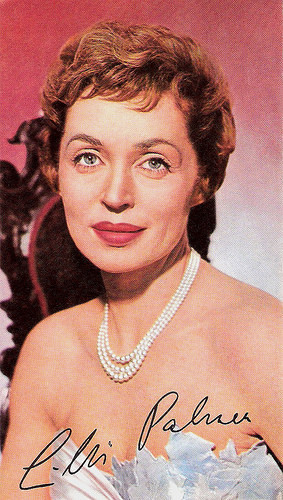
Lilli Palmer . German collectors card by Lux.
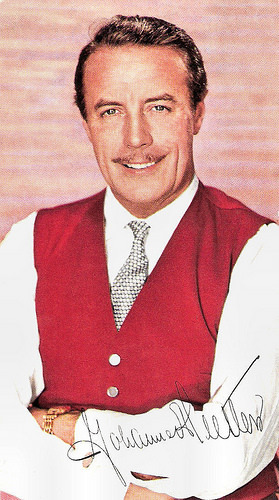
Johannes Heesters . German collectors card by Lux.
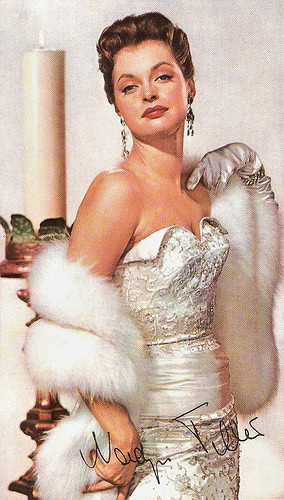
Nadja Tiller . German collectors card by Lux.
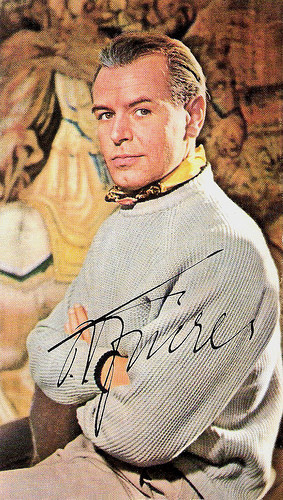
O.W. Fischer . German collectors card by Lux.
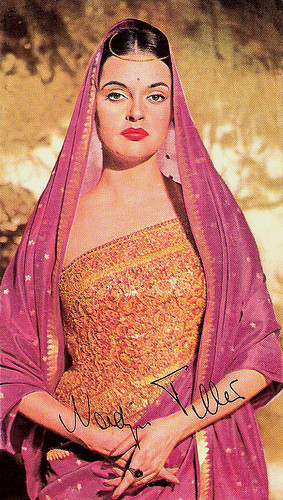
Nadja Tiller . German collectors card by Lux.
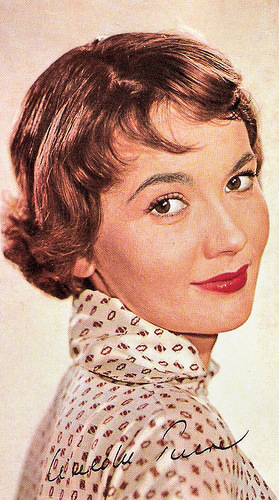
Liselotte Pulver . German collectors card by Lux.
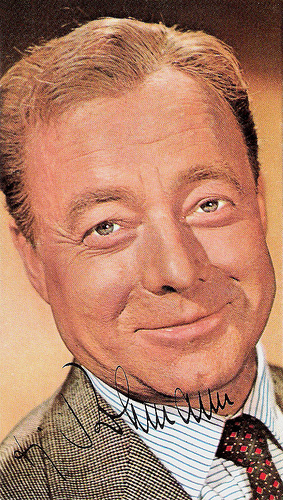
Heinz Rühmann . German collectors card by Lux.
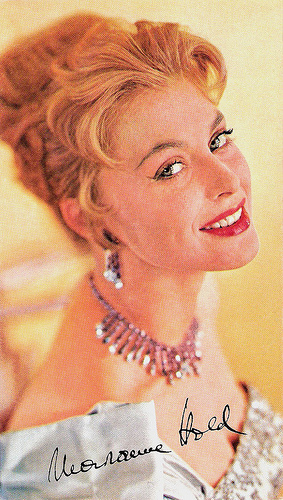
Marianne Hold . German collectors card by Lux.
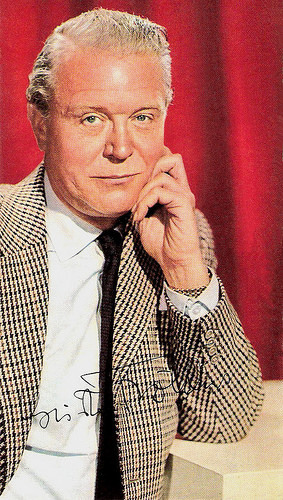
Gustav Fröhlich . German collectors card by Lux.
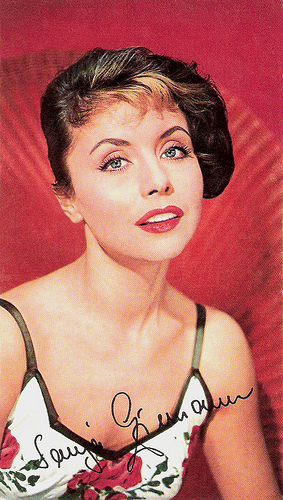
Sonja Ziemann . German collectors card by Lux.
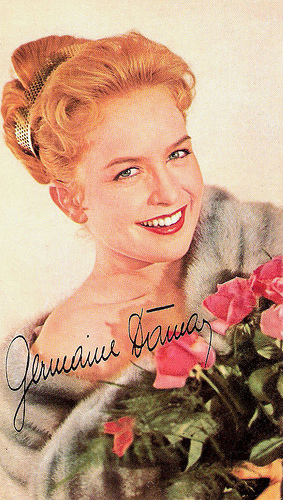
Germaine Damar . German collectors card by Lux.
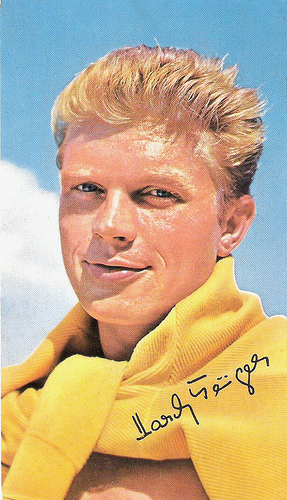
Hardy Krüger . German collectors card by Lux.
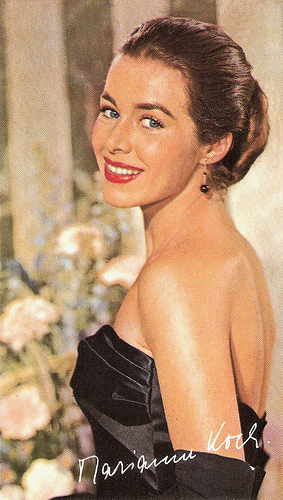
Marianne Koch . German collectors card by Lux.
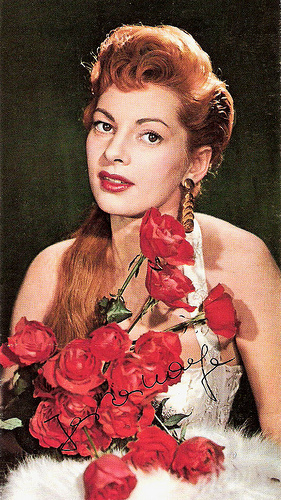
Jester Naefe . German collectors card by Lux.
Source: Wikipedia.
It is Postcard Friendship Friday, hosted by Beth at the The Best Hearts are Crunchy. You can visit her by clicking on the button below.


Lilli Palmer . German collectors card by Lux.

Johannes Heesters . German collectors card by Lux.

Nadja Tiller . German collectors card by Lux.

O.W. Fischer . German collectors card by Lux.

Nadja Tiller . German collectors card by Lux.

Liselotte Pulver . German collectors card by Lux.

Heinz Rühmann . German collectors card by Lux.

Marianne Hold . German collectors card by Lux.

Gustav Fröhlich . German collectors card by Lux.

Sonja Ziemann . German collectors card by Lux.

Germaine Damar . German collectors card by Lux.

Hardy Krüger . German collectors card by Lux.

Marianne Koch . German collectors card by Lux.

Jester Naefe . German collectors card by Lux.
Source: Wikipedia.
It is Postcard Friendship Friday, hosted by Beth at the The Best Hearts are Crunchy. You can visit her by clicking on the button below.

Published on January 25, 2018 22:00
January 24, 2018
Lorenzaccio (1918)
The Italian silent film Lorenzaccio (Giuseppe De Liguoro, 1918) was a production by Lux-Artis. Based on a story by Alfred de Musset, the film tells the story of Lorenzo de Medici. Actress Irene Saffo Momo played the title role.

Italian postcard. Photo: Lux-Artis. Publicity still for Lorenzaccio (Giuseppe De Liguoro, 1918), starring countess Irene Saffo Momo, in the middle on this card. Caption: I will think of the retro of this medal!... The card depicts the opening scene of the film, in which Lorenzaccio tells the artist Benvenuto Cellini (Camillo Talamo) who has to leave Florence on instigation of duke Alessandro (on the right, Camillo De Rossi), he will take care of it, confirming his own corruption and Cellini's integrity. This scene was suppressed in Alfred De Musset's play, even if it was in his manuscript.

Italian postcard. Publicity card for Lorenzaccio (Giuseppe De Liguoro, Lux-Artis 1918), starring Irene Saffo Momo, here on the right. Caption: Do you have an enemy, Master? (In a fake duel Lorenzaccio exposes his murderous intentions.)
Covered in blood
In Lorenzaccio (Giuseppe De Liguoro, 1918), young Lorenzo de Medici (Irene Saffo Momo), nicknamed Lorenzaccio, vows to restore the republic at Florence, but it is his own cousin Alessandro de' Medici (Camillo De Rossi), Duke of Florence, who rules as tyrant, helped by the Pope and the army of Emperor Charles V, who are the real powers.
Lorenzaccio becomes a loyal servant to the Duke, helps him in his debaucheries, abducting a girl under her brother's nose. Later the duke has set his eyes on the pious and married marchioness Cibo (Lia Monesi-Passaro), who is warned by her brother-in-law, the cardinal Cibo (Alberto Castelli), but she has decided to sacrifice herself and try to mould the duke in the right direction by offering herself.
Meanwhile Luisa Strozzi (Sara Long), member of the rival family to the Medici's, has an involuntary affair with marquis Giuliano Salvati (Luigi Saltamerendo), a man in the duke's circle.
In Lorenzaccio's palace, his uncle Bindo Altoviti and Venturi, a gentleman, wish to know from Lorenzaccio whether he will join their conspiracy against the duke. But when the duke, as suggested by his cousin, offers them a promotion and privileges, despite their republican talk, they immediately accept. This confirms Lorenzaccio the power of corruption.
Covered in blood, Pietro Strozzi appears to his father, the Republican Filippo (Ferdinando Del Re), and Lorenzo, saying he has killed Salviati because of his sister. When Alessandro serves as a - half naked - model for a portrait by Tebaldo Freccia (Adolfo Quintini), Lorenzaccio steals his coat of mail which always protected him and throws it in a well. Lorenzo has a mock duel with his aid, but becomes totally outrageous, predicting his murderous act.
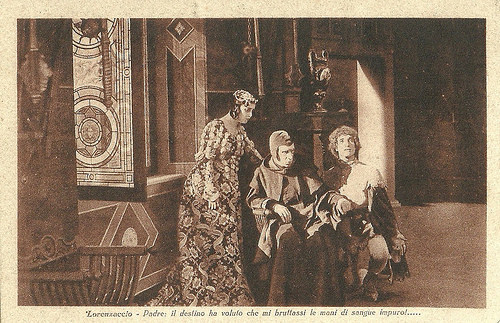
Italian postcard. Photo: Lux-Artis. Publicity still for Lorenzaccio (Giuseppe De Liguoro, 1918), starring Irene Saffo Momo. Caption: Father, destiny has wanted that I filthed my hands with impure blood! (Probably here Luisa Strozzi confesses her father Filippo she has been raped by Salviati.)
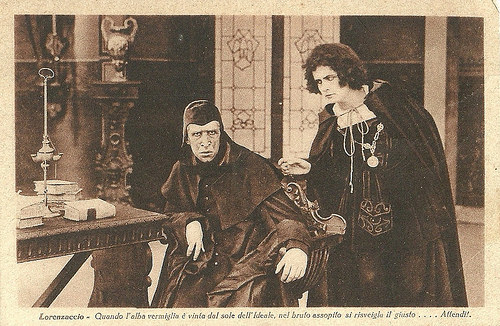
Italian postcard. Photo: Lux-Artis. Publicity still for Lorenzaccio (Giuseppe De Liguoro, 1918), with Irene Saffo Momo, here on the right. Caption: When the vermilion dawn has been conquered by the sun of the Ideal one, then in the ugly half-sleep the right one will awake... You wait! (Lorenzaccio warns Strozzi of his plan to murder the duke.)
Lorenzo's real intentions
The duke orders the arrest of Pietro, and his father, powerless, unmasks Lorenzo's real intentions. He can only leave for Florence, Lorenzaccio tells him. Strozzi's daughter dies before him, he finally wants to revenge himself but is struck down.
Pietro is freed and learns of his sister Luisa's death. The duke is pleased with Luisa's death, misses his coat of arms and has set his eyes on his young aunt Catherine. The night he proposes to kill his cousin, Lorenzaccio warns noblemen to prepare for revolt, but none of them believe he'll do it.
The cardinal warns the duke of Lorenzaccio, but he dismisses his warnings and follows his cousin to his bedroom, where Lorenzaccio kills him.
Lorenzaccio flees to Venice with Filippo Strozzi, but refuses his Republic ideals, accepts his fate and is murdered. The masterminding Cardinal Cibo appoints the docile Cosimo de' Medici to duke, on behalf of Pope Paul III and Emperor Charles V.
Since opponents to the tyrant's regime fail to use Alessandro's death as a way to overthrow the dukedom and establish a republic, Lorenzo's action does not appear to aid the people's welfare.
Written soon after the July Revolution of 1830, at the start of the July Monarchy, when King Louis Philippe substituted King Charles X of France, the play contains many cynical comments on the lack of true republican sentiments in the face of violent overthrow. While the original play was only intended to be read and not staged, it has been staged since, first by Sarah Bernhardt as a star vehicle for herself in 1896, and later with Gérard Philippe in the title role in the 1950s in Paris, a production which reached Broadway in the French version presented by the Théâtre national populaire and directed by Jean Vilar in 1958 for 7 performances.
Bernhardt's example of an actress playing the title role was followed many times after. The play's plot also served for several Italian film adaptations; after the 1918 one also Lorenzino de' Medici (Guido Brignone, 1935) and again for Lorenzaccio (Raffaello Pacini, 1954) with Giorgio Albertazzi as protagonist.
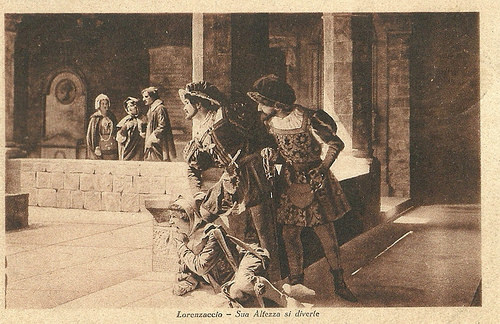
Italian postcard. Publicity card for Lorenzaccio (Giuseppe De Liguoro, 1918), starring Irene Saffo Momo. Caption: His Highness amuses himself.
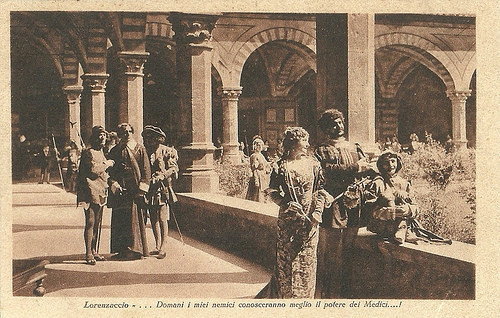
Italian postcard. Publicity card for Lorenzaccio (Giuseppe De Liguoro, 1918), starring Irene Saffo Momo. Caption: Tomorrow my enemies will know the power of the Medici...!
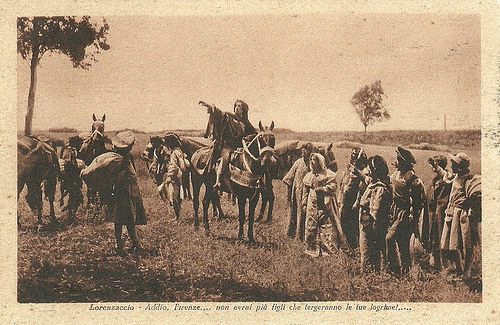
Italian postcard. Publicity card for Lorenzaccio (Giuseppe De Liguoro, 1918).
Source: Vittorio Martinelli (Il cinema muto italiano 1918), Wikipedia (Italian, English and German), and IMDb.

Italian postcard. Photo: Lux-Artis. Publicity still for Lorenzaccio (Giuseppe De Liguoro, 1918), starring countess Irene Saffo Momo, in the middle on this card. Caption: I will think of the retro of this medal!... The card depicts the opening scene of the film, in which Lorenzaccio tells the artist Benvenuto Cellini (Camillo Talamo) who has to leave Florence on instigation of duke Alessandro (on the right, Camillo De Rossi), he will take care of it, confirming his own corruption and Cellini's integrity. This scene was suppressed in Alfred De Musset's play, even if it was in his manuscript.

Italian postcard. Publicity card for Lorenzaccio (Giuseppe De Liguoro, Lux-Artis 1918), starring Irene Saffo Momo, here on the right. Caption: Do you have an enemy, Master? (In a fake duel Lorenzaccio exposes his murderous intentions.)
Covered in blood
In Lorenzaccio (Giuseppe De Liguoro, 1918), young Lorenzo de Medici (Irene Saffo Momo), nicknamed Lorenzaccio, vows to restore the republic at Florence, but it is his own cousin Alessandro de' Medici (Camillo De Rossi), Duke of Florence, who rules as tyrant, helped by the Pope and the army of Emperor Charles V, who are the real powers.
Lorenzaccio becomes a loyal servant to the Duke, helps him in his debaucheries, abducting a girl under her brother's nose. Later the duke has set his eyes on the pious and married marchioness Cibo (Lia Monesi-Passaro), who is warned by her brother-in-law, the cardinal Cibo (Alberto Castelli), but she has decided to sacrifice herself and try to mould the duke in the right direction by offering herself.
Meanwhile Luisa Strozzi (Sara Long), member of the rival family to the Medici's, has an involuntary affair with marquis Giuliano Salvati (Luigi Saltamerendo), a man in the duke's circle.
In Lorenzaccio's palace, his uncle Bindo Altoviti and Venturi, a gentleman, wish to know from Lorenzaccio whether he will join their conspiracy against the duke. But when the duke, as suggested by his cousin, offers them a promotion and privileges, despite their republican talk, they immediately accept. This confirms Lorenzaccio the power of corruption.
Covered in blood, Pietro Strozzi appears to his father, the Republican Filippo (Ferdinando Del Re), and Lorenzo, saying he has killed Salviati because of his sister. When Alessandro serves as a - half naked - model for a portrait by Tebaldo Freccia (Adolfo Quintini), Lorenzaccio steals his coat of mail which always protected him and throws it in a well. Lorenzo has a mock duel with his aid, but becomes totally outrageous, predicting his murderous act.

Italian postcard. Photo: Lux-Artis. Publicity still for Lorenzaccio (Giuseppe De Liguoro, 1918), starring Irene Saffo Momo. Caption: Father, destiny has wanted that I filthed my hands with impure blood! (Probably here Luisa Strozzi confesses her father Filippo she has been raped by Salviati.)

Italian postcard. Photo: Lux-Artis. Publicity still for Lorenzaccio (Giuseppe De Liguoro, 1918), with Irene Saffo Momo, here on the right. Caption: When the vermilion dawn has been conquered by the sun of the Ideal one, then in the ugly half-sleep the right one will awake... You wait! (Lorenzaccio warns Strozzi of his plan to murder the duke.)
Lorenzo's real intentions
The duke orders the arrest of Pietro, and his father, powerless, unmasks Lorenzo's real intentions. He can only leave for Florence, Lorenzaccio tells him. Strozzi's daughter dies before him, he finally wants to revenge himself but is struck down.
Pietro is freed and learns of his sister Luisa's death. The duke is pleased with Luisa's death, misses his coat of arms and has set his eyes on his young aunt Catherine. The night he proposes to kill his cousin, Lorenzaccio warns noblemen to prepare for revolt, but none of them believe he'll do it.
The cardinal warns the duke of Lorenzaccio, but he dismisses his warnings and follows his cousin to his bedroom, where Lorenzaccio kills him.
Lorenzaccio flees to Venice with Filippo Strozzi, but refuses his Republic ideals, accepts his fate and is murdered. The masterminding Cardinal Cibo appoints the docile Cosimo de' Medici to duke, on behalf of Pope Paul III and Emperor Charles V.
Since opponents to the tyrant's regime fail to use Alessandro's death as a way to overthrow the dukedom and establish a republic, Lorenzo's action does not appear to aid the people's welfare.
Written soon after the July Revolution of 1830, at the start of the July Monarchy, when King Louis Philippe substituted King Charles X of France, the play contains many cynical comments on the lack of true republican sentiments in the face of violent overthrow. While the original play was only intended to be read and not staged, it has been staged since, first by Sarah Bernhardt as a star vehicle for herself in 1896, and later with Gérard Philippe in the title role in the 1950s in Paris, a production which reached Broadway in the French version presented by the Théâtre national populaire and directed by Jean Vilar in 1958 for 7 performances.
Bernhardt's example of an actress playing the title role was followed many times after. The play's plot also served for several Italian film adaptations; after the 1918 one also Lorenzino de' Medici (Guido Brignone, 1935) and again for Lorenzaccio (Raffaello Pacini, 1954) with Giorgio Albertazzi as protagonist.

Italian postcard. Publicity card for Lorenzaccio (Giuseppe De Liguoro, 1918), starring Irene Saffo Momo. Caption: His Highness amuses himself.

Italian postcard. Publicity card for Lorenzaccio (Giuseppe De Liguoro, 1918), starring Irene Saffo Momo. Caption: Tomorrow my enemies will know the power of the Medici...!

Italian postcard. Publicity card for Lorenzaccio (Giuseppe De Liguoro, 1918).
Source: Vittorio Martinelli (Il cinema muto italiano 1918), Wikipedia (Italian, English and German), and IMDb.
Published on January 24, 2018 22:00
January 23, 2018
Willy Millowitsch
Willy Millowitsch (1909-1999) was a popular German stage and TV actor and the director of the Volkstheater Millowitsch in Cologne. From 1949 on, he appeared in many West-German and Austrian films.
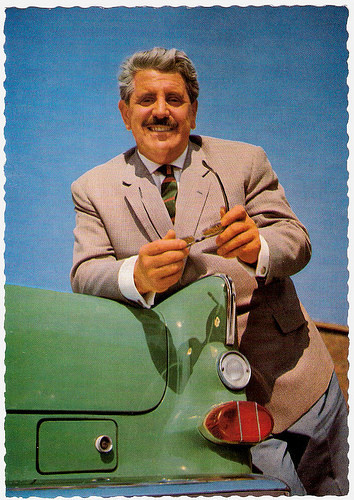
German postcard by Universum-Film Aktiengesellschaft (Ufa), Berlin-Tempelhof, no. CK 417. Photo: Millowitsch Theater.
A long family tradition
Willy Millowitsch was born in Cologne in the Rhineland region in Germany, in 1909. His parents were Peter and Käthe Millowitsch and came from a long family tradition of engagement with the theatre which can be traced back to 1792. It was not until 1895 however, that Millowitsch's grandfather stopped using puppets and resorted to real actors instead.
Millowitsch was interested in theatre at an early age, and took to the stage for the first time in 1922 at just 13. According to IMDb , he had intended to become an engineer, but he quit school without a degree to pursue his acting career full-time.
At first, he worked under the auspices of his father who had to give up his theatre after the inflation hit. This forced them to go on tour in and around Cologne until they got a permanent theatre in 1936, the now famous Volkstheater Millowitsch, which Willy took over from his father in 1940.
In 1933, he had his first film appearances in two short film comedies, So leben wir alle Tage/That’s how we always live (Hasso Preiß, 1933) and Wenn Männer kochen/When men cook (Hasso Preiß, 1933).
In 1939 he married his first wife Lini Lüttgen, but they got divorced soon after. During World War II, the theatre was damaged, but not severely, and by October 1945 it was fully restored, owing to the support of mayor and later German chancellor, Konrad Adenauer, who proclaimed that the people need something to laugh about again.
Consequently, in the time from 1945 to 1949 there were daily performances in the theatre. It was during this time that he met his second wife, Gerda Millowitsch, formerly Feldhoff. They remained married till his death.
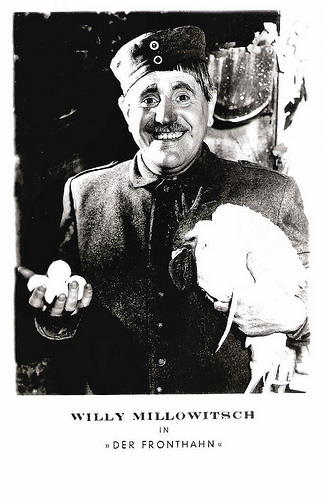
German postcard by Netter's Starverlag, Berlin. Photo: publicity still for the play Der Fronthahn/The Front Rooster.
A relaxed lifestyle and genial humour
In 1949, when the post-war theatre euphoria died down, Willy Millowitsch focused on his film and television career. In 1949 he played a supporting part in the West-German crime film Gesucht wird Majora/Search for Majora (Hermann Pfeiffer, 1949) starring Lotte Koch .
Next, he appeared in the drama Madonna in Ketten/Madonna in Chains (Gerhard Lamprecht, 1949), starring Lotte Koch , Karin Hardt and Elisabeth Flickenschildt. He also appeared in one of the last Harry Piel adventure films, Der Tiger Akbar/Tiger’s Claw (Harry Piel, 1951). Many more films were to follow.
He did not content himself just transferring from one medium to the other, but brought the theatre with him. In 1953 the Kölsch (Cologne dialect) play Der Etappenhase (The stage hare) was broadcast on the TV channel WDR, the first live broadcast of a theatrical performance with real audience in German television history.
Despite bitter criticism of the entry of low 'folk culture' into television by the director of the NDR channel, Adolf Grimme, it was an instant success. This remains one of Millowitsch's most popular plays and has been performed more than 1,000 times. Der Etappenhase was so popular that just six weeks later it was broadcast again, live from the Volkstheater. In 1957, it was made into a film, Der Etappenhase (Wolfgang Becker, 1957), but with Beppo Brem in the leading role and Millowitsch in a supporting part.
Millowitsch continued to put on television plays that were instant successes, gaining national popularity. It is in great part Millowitsch's achievement to have popularised Kölsch throughout Germany. People were now associating the Rhinelander with a relaxed lifestyle and genial humour. Theatres from other dialectal areas scrambled to catch up with him and soon the dialect theatre became an important part of the German television landscape.
With the success of these plays on television, interest in theatre gradually increased and by the 1960s flocks of people took to the theatre again to witness performance of Millowitsch's popular plays first hand. Until the beginning of the 1960s, Millowitsch had to rent out his theatre now and again, but with the arrival of the new crowds Millowitsch could afford to concentrate his career on theatre from then on. He renovated the theatre in 1967 and the Volkstheater once again became a focal point of local culture, and many young dialect artists started their careers there.
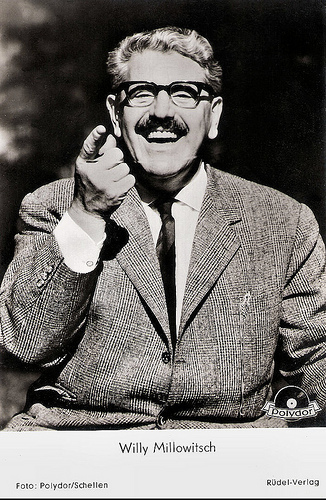
German postcard by Rüdel-Verlag, Hamburg-Bergedorf, no. 3484. Photo: Polydor / Schellen.
Who the devil were those people?
In the early 1960s, Willy Millowitsch had also moved on from supporting to starring parts in films. He was the title figure in the West German comedy Der wahre Jakob/The True Jacob (Rudolf Schündler, 1960) and his co-stars were Renate Ewert and Jane Tilden. The film was a remake of the popular German comedy Der wahre Jakob/True Jacob (Hans Steihoff, 1931), starring Ralph Arthur Roberts .
Next Millowitsch starred in Willy, der Privatdetektiv/Willy the Private Detective (Rudolf Schündler, 1960) with Renate Mannhardt and Rudolf Platte , Der Hochtourist/The high-season tourist (Ulrich Erfurth, 1961) with Claude Farell , and Robert und Bertram/Robert und Bertram (Hans Deppe, 1961) opposite Vico Torriani and Trude Herr.
The latter comedy was inspired by the characters in Gustav Raeder's 1856 play Robert and Bertram, updated to the modern era. Two vagabonds, Robert and Bertram, are hired by a shoe company to walk 500 kilometres to test their new product.
Millowitsch also appeared in the film operettas Die Fledermaus/The Bat (Géza von Cziffra, 1962), starring Peter Alexander , Marianne Koch and Marika Rökk , and Der Zigeunerbaron/The Gypsy Baron (Kurt Wilhelm, 1962) with Carlos Thompson and Heidi Brühl .
Throughout the 1970s, Willy Millowitsch stuck mostly to the folk theatre. With his son Peter Millowitsch, he appeared in the Roy Black vehicle Alter Kahn und junge Liebe/Old Barge, Young Love (Werner Jacobs, 1973).
At the end of the 1980s he returned to television and took the title role in a detective series as Kommissar Klefisch, whom he played until 1996. He played a small part in the Hollywood comedy National Lampoon's European Vacation (Amy Heckerling, 1985) with Chevy Chase. His single line was "Wer zum Teufel waren die Leute?" (Who the devil were those people?).
Aside from his theatrical merits, he also wrote classic popular folk songs, such as Schnaps, das war sein letztes Wort and Wir sind alle kleine Sünderlein. He also embraced political causes and in 1992 he participated in the important anti-Nazi campaign, Arsch huh, Zäng ussenander! (Kölsch, meaning: Move your butts and pipe up!), which culminated in a major concert by local acts attended by 100,000 people at Cologne's Chlodwigplatz.
In 1989, the city of Cologne conferred honorary citizenship on to Millowitsch, which is a very exclusive honour in Germany. In 1995, he retired from performing for health reasons. He celebrated his 90th birthday on 8 January 1999, with 18,000 fans at a sold-out event at the Köln arena and told people all he wanted for his birthday was to stay healthy.
However, Willy Millowitsch died of heart failure on 20 September that year. Two of his four children, Peter Millowitsch, who is now the director of the Volkstheater, and Mariele Millowitsch have continued the family tradition and have both become successful actors. The city of Cologne has named a square near the Millowitsch theatre Willy-Millowitsch-Platz in his honour.
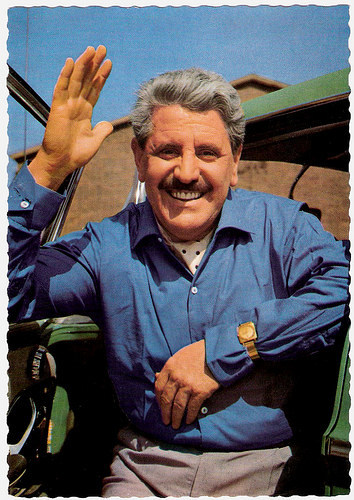
German postcard by Universum-Film Aktiengesellschaft (Ufa), Berlin-Tempelhof, no. CK 418. Photo: Millowitsch Theater.
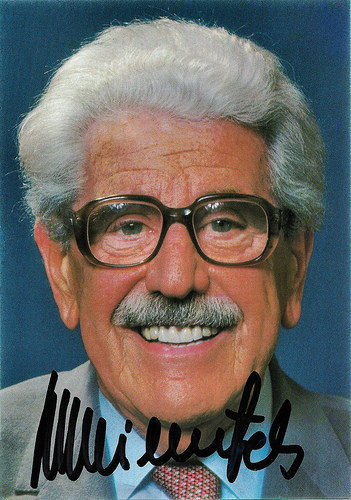
German autograph card by Papagayo Photo: Augl.
Sources: Wikipedia (English and German), and .

German postcard by Universum-Film Aktiengesellschaft (Ufa), Berlin-Tempelhof, no. CK 417. Photo: Millowitsch Theater.
A long family tradition
Willy Millowitsch was born in Cologne in the Rhineland region in Germany, in 1909. His parents were Peter and Käthe Millowitsch and came from a long family tradition of engagement with the theatre which can be traced back to 1792. It was not until 1895 however, that Millowitsch's grandfather stopped using puppets and resorted to real actors instead.
Millowitsch was interested in theatre at an early age, and took to the stage for the first time in 1922 at just 13. According to IMDb , he had intended to become an engineer, but he quit school without a degree to pursue his acting career full-time.
At first, he worked under the auspices of his father who had to give up his theatre after the inflation hit. This forced them to go on tour in and around Cologne until they got a permanent theatre in 1936, the now famous Volkstheater Millowitsch, which Willy took over from his father in 1940.
In 1933, he had his first film appearances in two short film comedies, So leben wir alle Tage/That’s how we always live (Hasso Preiß, 1933) and Wenn Männer kochen/When men cook (Hasso Preiß, 1933).
In 1939 he married his first wife Lini Lüttgen, but they got divorced soon after. During World War II, the theatre was damaged, but not severely, and by October 1945 it was fully restored, owing to the support of mayor and later German chancellor, Konrad Adenauer, who proclaimed that the people need something to laugh about again.
Consequently, in the time from 1945 to 1949 there were daily performances in the theatre. It was during this time that he met his second wife, Gerda Millowitsch, formerly Feldhoff. They remained married till his death.

German postcard by Netter's Starverlag, Berlin. Photo: publicity still for the play Der Fronthahn/The Front Rooster.
A relaxed lifestyle and genial humour
In 1949, when the post-war theatre euphoria died down, Willy Millowitsch focused on his film and television career. In 1949 he played a supporting part in the West-German crime film Gesucht wird Majora/Search for Majora (Hermann Pfeiffer, 1949) starring Lotte Koch .
Next, he appeared in the drama Madonna in Ketten/Madonna in Chains (Gerhard Lamprecht, 1949), starring Lotte Koch , Karin Hardt and Elisabeth Flickenschildt. He also appeared in one of the last Harry Piel adventure films, Der Tiger Akbar/Tiger’s Claw (Harry Piel, 1951). Many more films were to follow.
He did not content himself just transferring from one medium to the other, but brought the theatre with him. In 1953 the Kölsch (Cologne dialect) play Der Etappenhase (The stage hare) was broadcast on the TV channel WDR, the first live broadcast of a theatrical performance with real audience in German television history.
Despite bitter criticism of the entry of low 'folk culture' into television by the director of the NDR channel, Adolf Grimme, it was an instant success. This remains one of Millowitsch's most popular plays and has been performed more than 1,000 times. Der Etappenhase was so popular that just six weeks later it was broadcast again, live from the Volkstheater. In 1957, it was made into a film, Der Etappenhase (Wolfgang Becker, 1957), but with Beppo Brem in the leading role and Millowitsch in a supporting part.
Millowitsch continued to put on television plays that were instant successes, gaining national popularity. It is in great part Millowitsch's achievement to have popularised Kölsch throughout Germany. People were now associating the Rhinelander with a relaxed lifestyle and genial humour. Theatres from other dialectal areas scrambled to catch up with him and soon the dialect theatre became an important part of the German television landscape.
With the success of these plays on television, interest in theatre gradually increased and by the 1960s flocks of people took to the theatre again to witness performance of Millowitsch's popular plays first hand. Until the beginning of the 1960s, Millowitsch had to rent out his theatre now and again, but with the arrival of the new crowds Millowitsch could afford to concentrate his career on theatre from then on. He renovated the theatre in 1967 and the Volkstheater once again became a focal point of local culture, and many young dialect artists started their careers there.

German postcard by Rüdel-Verlag, Hamburg-Bergedorf, no. 3484. Photo: Polydor / Schellen.
Who the devil were those people?
In the early 1960s, Willy Millowitsch had also moved on from supporting to starring parts in films. He was the title figure in the West German comedy Der wahre Jakob/The True Jacob (Rudolf Schündler, 1960) and his co-stars were Renate Ewert and Jane Tilden. The film was a remake of the popular German comedy Der wahre Jakob/True Jacob (Hans Steihoff, 1931), starring Ralph Arthur Roberts .
Next Millowitsch starred in Willy, der Privatdetektiv/Willy the Private Detective (Rudolf Schündler, 1960) with Renate Mannhardt and Rudolf Platte , Der Hochtourist/The high-season tourist (Ulrich Erfurth, 1961) with Claude Farell , and Robert und Bertram/Robert und Bertram (Hans Deppe, 1961) opposite Vico Torriani and Trude Herr.
The latter comedy was inspired by the characters in Gustav Raeder's 1856 play Robert and Bertram, updated to the modern era. Two vagabonds, Robert and Bertram, are hired by a shoe company to walk 500 kilometres to test their new product.
Millowitsch also appeared in the film operettas Die Fledermaus/The Bat (Géza von Cziffra, 1962), starring Peter Alexander , Marianne Koch and Marika Rökk , and Der Zigeunerbaron/The Gypsy Baron (Kurt Wilhelm, 1962) with Carlos Thompson and Heidi Brühl .
Throughout the 1970s, Willy Millowitsch stuck mostly to the folk theatre. With his son Peter Millowitsch, he appeared in the Roy Black vehicle Alter Kahn und junge Liebe/Old Barge, Young Love (Werner Jacobs, 1973).
At the end of the 1980s he returned to television and took the title role in a detective series as Kommissar Klefisch, whom he played until 1996. He played a small part in the Hollywood comedy National Lampoon's European Vacation (Amy Heckerling, 1985) with Chevy Chase. His single line was "Wer zum Teufel waren die Leute?" (Who the devil were those people?).
Aside from his theatrical merits, he also wrote classic popular folk songs, such as Schnaps, das war sein letztes Wort and Wir sind alle kleine Sünderlein. He also embraced political causes and in 1992 he participated in the important anti-Nazi campaign, Arsch huh, Zäng ussenander! (Kölsch, meaning: Move your butts and pipe up!), which culminated in a major concert by local acts attended by 100,000 people at Cologne's Chlodwigplatz.
In 1989, the city of Cologne conferred honorary citizenship on to Millowitsch, which is a very exclusive honour in Germany. In 1995, he retired from performing for health reasons. He celebrated his 90th birthday on 8 January 1999, with 18,000 fans at a sold-out event at the Köln arena and told people all he wanted for his birthday was to stay healthy.
However, Willy Millowitsch died of heart failure on 20 September that year. Two of his four children, Peter Millowitsch, who is now the director of the Volkstheater, and Mariele Millowitsch have continued the family tradition and have both become successful actors. The city of Cologne has named a square near the Millowitsch theatre Willy-Millowitsch-Platz in his honour.

German postcard by Universum-Film Aktiengesellschaft (Ufa), Berlin-Tempelhof, no. CK 418. Photo: Millowitsch Theater.

German autograph card by Papagayo Photo: Augl.
Sources: Wikipedia (English and German), and .
Published on January 23, 2018 22:00
January 22, 2018
Christel Bodenstein
German film and television actress Christel Bodenstein (1938) appeared in many East German (GDR) productions and is best known for her leading role as the beautiful but haughty princess in the fairy-tale film Das singende, klingende Bäumchen/The Singing Ringing Tree (1957).
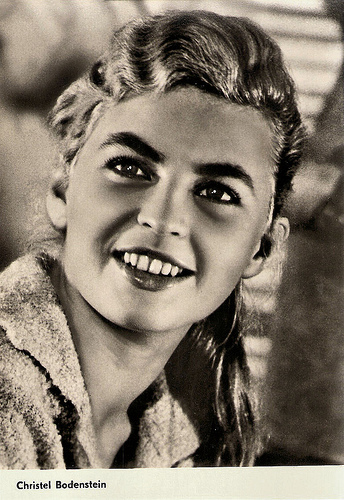
East-German postcard by VEB Progress Film-Vertrieb, no. 1582, 1961.
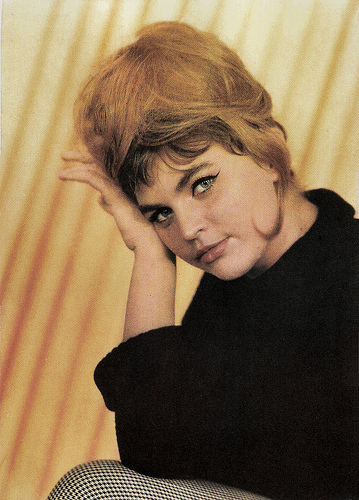
East-German postcard by VEB Progress Film-Vertrieb, no. 2250, 1965. Photo: DEWAG / Herbst / Mücke.
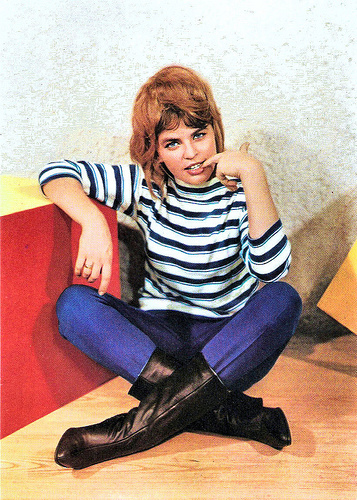
East-German postcard by VEB Progress Film-Vertrieb, no. 2252, 1965. Photo: DEWAG / Herbst / Mücke.
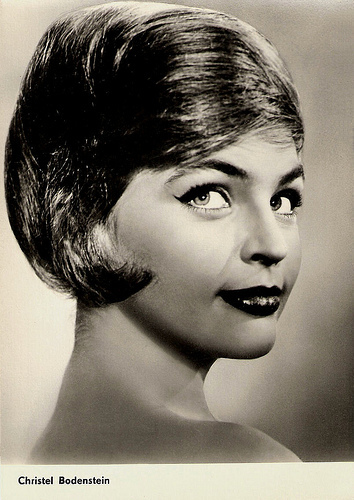
East-German postcard by VEB Progress Film-Vertrieb, no. 1893, 1963. Photo: DEFA / Blümel.
The Singing Ringing Tree
Christel Bodenstein was born Christa Bodenstein in 1938 in Munich, Germany. In 1949, she moved to Leipzig in the GDR with her mother. She attended the ballet school of the Leipzig Opera and the State Ballet School, Berlin. In 1955, she graduated there and became a ballet dancer at the Landestheater Halle.
The then 17-year-old met DEFA director Kurt Maetzig at the Ostseestrand. He suggested her to do screen test for the part of Annegret in his DEFA film Schlösser und Katen/Castles and Cottages (1957), but she did not get the role. Instead actress Karla Runkehl was chosen to play Annegret.
Despite this failure, Bodenstein studied until 1959 at the Academy of Film and Television in Potsdam. She made her film debut as student Hannelore Ulrich in the satire Das Hauptmann von Köln/The Captain from Cologne (Slatan Dudow, 1956) starring Rolf Ludwig, followed by the fairy-tale film Das tapfere Schneiderlein/The Brave Little Tailor (Helmut Spieß, 1956) with Kurt Schmidtchen. The film was the first of 19 adaptations of Grimm fairy tales, which the East German studio DEFA realised until 1990.
Bodenstein’s breakthrough was another fairy-tale film by the DEFA, Das singende, klingende Bäumchen/The Singing Ringing Tree (Francesco Stefani, 1957). The story, written by Anne Geelhaar, was based on a variation of Hurleburlebutz by the Grimm Brothers. Bodenstein played a beautiful but selfish and haughty princess who rejects the proposal of a wealthy prince (Eckart Dux).
After its release in East Germany, the film sold almost 6 million tickets in the country of about 17 million. Das singende, klingende Bäumchen was then purchased by the BBC and cut into three parts to create a mini-series which was shown many times during the 1960s and 1970s.
Other popular successes were the DEFA musical Maibowle/The Punch Bowl (Günter Reisch, 1959) and its sequel Silvesterpunsch/New Year's Eve Punch (Günter Reisch, 1960), in which she costarred with Erich Franz, Friedel Nowack and Erika Dunkelmann. In these films, she could show off her dancing talent.

East-German postcard by VEB DEFA-Studio für Spielfilme, Potsdam-Babelsberg, no. 72, 1956. Photo: DEFA / Wenzel.
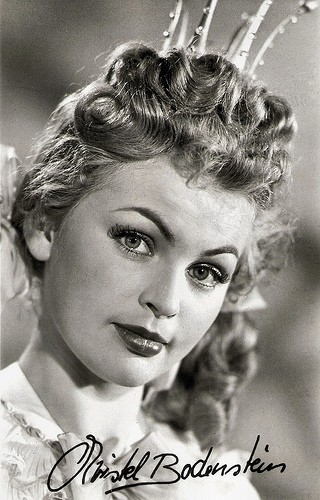
East-German postcard by VEB Progress Film-Vertrieb, no. 4213/447, 1957. Photo: DEFA / Wunsch. Publicity still for Das singende, klingende Bäumchen/The Singing Ringing Tree (Francesco Stefani, 1957).
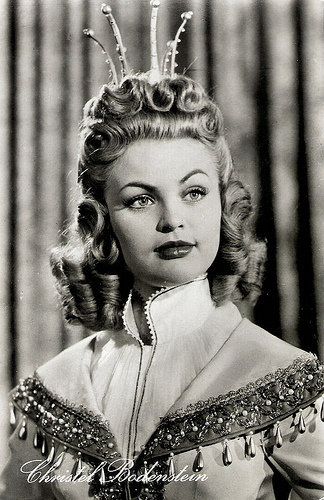
East-German postcard by VEB Progress Film-Vertrieb, no. 4219/463, 1958. Photo: DEFA / Wunsch. Publicity still for Das singende, klingende Bäumchen/The Singing Ringing Tree (Francesco Stefani, 1957).
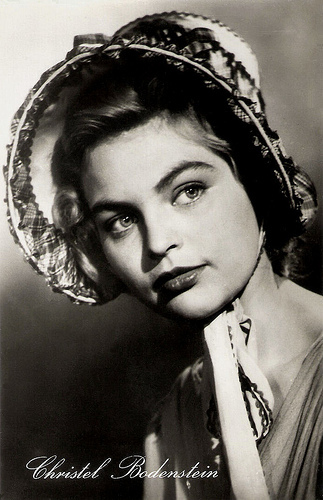
East-German postcard by VEB Progress Film-Vertrieb, no. 659, 1958. Photo: Jochen Diestelmann.
One of the great romantic couples of the GDR
In 1960, Christel Bodenstein was voted the most popular actress of the GDR by the youth magazine Neues Leben. Through her popularity, she became a member of the DEFA ensemble from 1959 to 1973 and she worked with renowned film directors such as Frank Vogel, Herbert Ballmann and Martin Hellberg.
Bodenstein married director Konrad Wolf in 1960 and they had a son Mirko in 1961. In the 1960s, she appeared in some musicals and revue films such as Revue um Mitternacht/Midnight Review (Gottfried Kolditz, 1962) alongside Manfred Krug . Bodenstein and Krug reunited in Beschreibung eines Sommers/Description of a summer (Ralf Kirsten, 1963). The film made them one of the great romantic couples of the GDR.
This was followed by the fairy-tale film Der kleine Prinz/The Little Prince (Konrad Wolf, 1966) based on the story by Antoine de Saint-Exupéry. Bodenstein played the prince and Eberhard Esche the pilot.
In the 1970s, good and interesting film roles for the DEFA and the television of the GDR failed to materialise. She decided to return to the stage. From 1973 to 1976 she performed as a chanson singer, and was a temporary guest actress at the Maxim Gorki Theater in Berlin and the Hans Otto Theater in Potsdam.
In 1976, she started to work for the small theatre Das Ei at the Friedrichstadt-Palast in Berlin. After the Wende, the German reunification of 1990, she worked as an assistant director and in 1994 she became a director at Berlin’s Friedrichstadtpalast. Since then, her productions included a Claire Waldorff revue and the revue Sommernachtsträume/Summer nights dreams (1995).
Bodenstein and Wolf divorced in 1978. Her second marriage is to the actor and playwright Hasso von Lenski. In 2016, Christel Bodenstein returned to the screen in a new TV version of Das singende, klingende Bäumchen/The Singing Ringing Tree (Wolfgang Eißler, 2016), now with Jytte-Merle Böhrnsen as the princess and with Bodenstein in a supporting part as a herbalist.
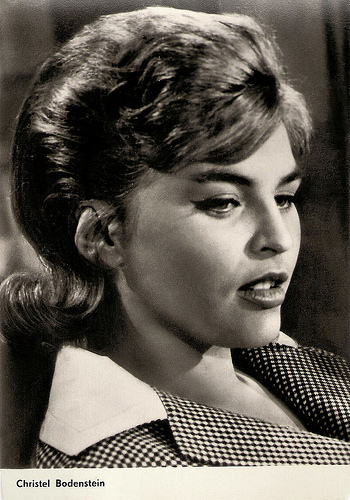
East-German postcard by VEB Progress Film-Vertrieb, no. 1658, 1962.
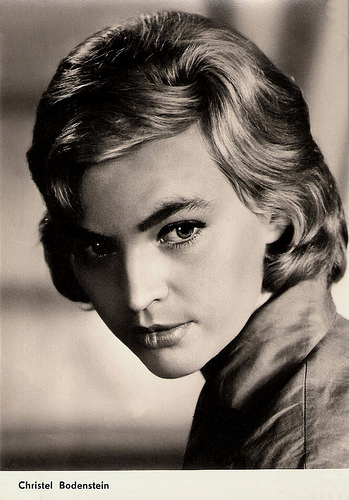
East-German postcard by VEB Progress Film-Vertrieb, no. 1817, 1963. Photo: Karin Blasig.
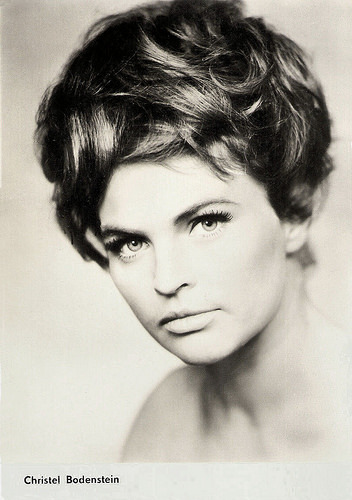
East-German postcard by VEB Progress Film-Vertrieb, no. 2333, 1966. Photo: Karin Blasig.
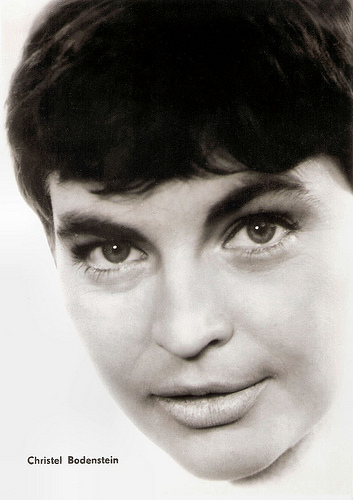
East-German postcard by VEB Progress Film-Vertrieb, no. 3312, 1968. Photo: Karin Blasig.
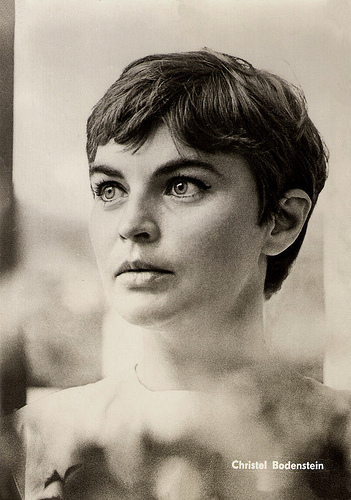
East-German postcard by VEB Progress Film-Vertrieb, no. 55/69, 1969. Photo: Klaus D. Schwarz.
Sources: Ines Walk (Film-Zeit.de – German), Filmportal.de, Wikipedia (English and German), and .

East-German postcard by VEB Progress Film-Vertrieb, no. 1582, 1961.

East-German postcard by VEB Progress Film-Vertrieb, no. 2250, 1965. Photo: DEWAG / Herbst / Mücke.

East-German postcard by VEB Progress Film-Vertrieb, no. 2252, 1965. Photo: DEWAG / Herbst / Mücke.

East-German postcard by VEB Progress Film-Vertrieb, no. 1893, 1963. Photo: DEFA / Blümel.
The Singing Ringing Tree
Christel Bodenstein was born Christa Bodenstein in 1938 in Munich, Germany. In 1949, she moved to Leipzig in the GDR with her mother. She attended the ballet school of the Leipzig Opera and the State Ballet School, Berlin. In 1955, she graduated there and became a ballet dancer at the Landestheater Halle.
The then 17-year-old met DEFA director Kurt Maetzig at the Ostseestrand. He suggested her to do screen test for the part of Annegret in his DEFA film Schlösser und Katen/Castles and Cottages (1957), but she did not get the role. Instead actress Karla Runkehl was chosen to play Annegret.
Despite this failure, Bodenstein studied until 1959 at the Academy of Film and Television in Potsdam. She made her film debut as student Hannelore Ulrich in the satire Das Hauptmann von Köln/The Captain from Cologne (Slatan Dudow, 1956) starring Rolf Ludwig, followed by the fairy-tale film Das tapfere Schneiderlein/The Brave Little Tailor (Helmut Spieß, 1956) with Kurt Schmidtchen. The film was the first of 19 adaptations of Grimm fairy tales, which the East German studio DEFA realised until 1990.
Bodenstein’s breakthrough was another fairy-tale film by the DEFA, Das singende, klingende Bäumchen/The Singing Ringing Tree (Francesco Stefani, 1957). The story, written by Anne Geelhaar, was based on a variation of Hurleburlebutz by the Grimm Brothers. Bodenstein played a beautiful but selfish and haughty princess who rejects the proposal of a wealthy prince (Eckart Dux).
After its release in East Germany, the film sold almost 6 million tickets in the country of about 17 million. Das singende, klingende Bäumchen was then purchased by the BBC and cut into three parts to create a mini-series which was shown many times during the 1960s and 1970s.
Other popular successes were the DEFA musical Maibowle/The Punch Bowl (Günter Reisch, 1959) and its sequel Silvesterpunsch/New Year's Eve Punch (Günter Reisch, 1960), in which she costarred with Erich Franz, Friedel Nowack and Erika Dunkelmann. In these films, she could show off her dancing talent.

East-German postcard by VEB DEFA-Studio für Spielfilme, Potsdam-Babelsberg, no. 72, 1956. Photo: DEFA / Wenzel.

East-German postcard by VEB Progress Film-Vertrieb, no. 4213/447, 1957. Photo: DEFA / Wunsch. Publicity still for Das singende, klingende Bäumchen/The Singing Ringing Tree (Francesco Stefani, 1957).

East-German postcard by VEB Progress Film-Vertrieb, no. 4219/463, 1958. Photo: DEFA / Wunsch. Publicity still for Das singende, klingende Bäumchen/The Singing Ringing Tree (Francesco Stefani, 1957).

East-German postcard by VEB Progress Film-Vertrieb, no. 659, 1958. Photo: Jochen Diestelmann.
One of the great romantic couples of the GDR
In 1960, Christel Bodenstein was voted the most popular actress of the GDR by the youth magazine Neues Leben. Through her popularity, she became a member of the DEFA ensemble from 1959 to 1973 and she worked with renowned film directors such as Frank Vogel, Herbert Ballmann and Martin Hellberg.
Bodenstein married director Konrad Wolf in 1960 and they had a son Mirko in 1961. In the 1960s, she appeared in some musicals and revue films such as Revue um Mitternacht/Midnight Review (Gottfried Kolditz, 1962) alongside Manfred Krug . Bodenstein and Krug reunited in Beschreibung eines Sommers/Description of a summer (Ralf Kirsten, 1963). The film made them one of the great romantic couples of the GDR.
This was followed by the fairy-tale film Der kleine Prinz/The Little Prince (Konrad Wolf, 1966) based on the story by Antoine de Saint-Exupéry. Bodenstein played the prince and Eberhard Esche the pilot.
In the 1970s, good and interesting film roles for the DEFA and the television of the GDR failed to materialise. She decided to return to the stage. From 1973 to 1976 she performed as a chanson singer, and was a temporary guest actress at the Maxim Gorki Theater in Berlin and the Hans Otto Theater in Potsdam.
In 1976, she started to work for the small theatre Das Ei at the Friedrichstadt-Palast in Berlin. After the Wende, the German reunification of 1990, she worked as an assistant director and in 1994 she became a director at Berlin’s Friedrichstadtpalast. Since then, her productions included a Claire Waldorff revue and the revue Sommernachtsträume/Summer nights dreams (1995).
Bodenstein and Wolf divorced in 1978. Her second marriage is to the actor and playwright Hasso von Lenski. In 2016, Christel Bodenstein returned to the screen in a new TV version of Das singende, klingende Bäumchen/The Singing Ringing Tree (Wolfgang Eißler, 2016), now with Jytte-Merle Böhrnsen as the princess and with Bodenstein in a supporting part as a herbalist.

East-German postcard by VEB Progress Film-Vertrieb, no. 1658, 1962.

East-German postcard by VEB Progress Film-Vertrieb, no. 1817, 1963. Photo: Karin Blasig.

East-German postcard by VEB Progress Film-Vertrieb, no. 2333, 1966. Photo: Karin Blasig.

East-German postcard by VEB Progress Film-Vertrieb, no. 3312, 1968. Photo: Karin Blasig.

East-German postcard by VEB Progress Film-Vertrieb, no. 55/69, 1969. Photo: Klaus D. Schwarz.
Sources: Ines Walk (Film-Zeit.de – German), Filmportal.de, Wikipedia (English and German), and .
Published on January 22, 2018 22:00
January 21, 2018
Elsa De Giorgi
Italian stage and screen actress Elsa De Giorgi (1914-1997) worked also as a director and set designer and was a successful novelist. She had a prolific career in the Italian cinema under Mussolini, and after the war she worked on stage with Luchino Visconti and Giorgi Strehler and in films by Pier Paolo Pasolini. But she is now best remembered for her extramarital affair with author Italo Calvino.
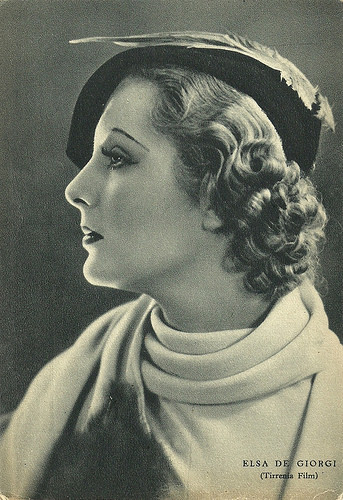
Italian postcard by Rizzoli, Milano, 1938. Photo: Tirrenia Film.
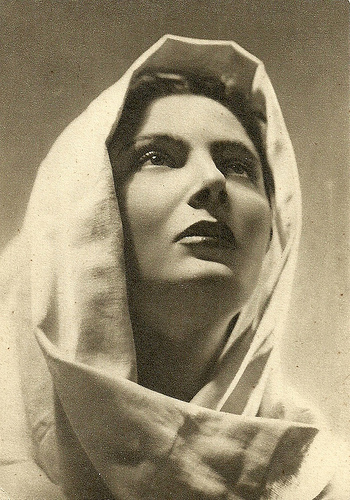
Italian postcard by Fotoluxardo, Roma. Publicity card for Melloni textiles, Bologna.
Ancient provincial aristocracy
Elsa De Giorgi was born Elsa Giorgi Alberti in 1914 in Pesaro. Her family was of ancient provincial aristocracy, the Giorgi Alberti’s, nobles of Bevagna and Camerino, patricians of Spoleto.
At the age of almost 18, she participated in a photographic competition. She was discovered by film director Mario Camerini, who offered her the role of the protagonist in T'amerò sempre/I will always love you (1933). In this film, a girl (De Giorgi) gives birth to a daughter but the father, a playboy (Mino Doro), has dumped her. Years after, they meet again, but there is also the girl’s colleague, an accountant (Nino Besozzi).
After this film debut, titles followed like the comedy L'impiegata di papà/Dad's clerk (Alessandro Blasetti, 1934) with Memo Benassi, the drama Porto/Port (Amleto Palermi, 1934) with Irma Grammatica and Camillo Pilotto , and Teresa Confalonieri/Loyalty of Love (Guido Brignone, 1934) with Marta Abba.
In the Luigi Pirandello adaptation Ma non è una cosa seria/But It's Nothing Serious (Mario Camerini, 1937) and La mazurca di papà/Daddy's mazurca (Oreste Biancoli 1938), she co-starred with Vittorio De Sica , and in La signora Paradiso (Enrico Guazzoni 1937), she had the lead role opposite Mino Doro and Memo Benassi.
Towards and during the war, De Giorgi often played in period pieces. This started with the lead role as Desirée Clary, Napoleon’s beloved in La sposa dei re/The Bride of the Kings (Duilio Coletti 1938) with Augusto Marcacci as Napoleon Bonaparte.
Other historical films with her are Il fornaretto di Venezia/The Fornaretto of Venice (Duilio Coletti, 1939) starring Roberto Villa as the unjustly accused, Capitan Fracassa/Captain Fracasse (Duilio Coletti, 1940) with Giorgio Costantini and Osvaldo Valenti, Fra' Diavolo/The Adventures of Fra Diavolo (Luigi Zampa, 1942) with Enzo Fiermonte, and La locandiera/The Innkeeper (Luigi Chiarini, 1944) starring Luisa Ferida .
In several of the wartime films De Giorgi was not allowed to have her own voice, and it was mainly Lydia Simoneschi who dubbed her.
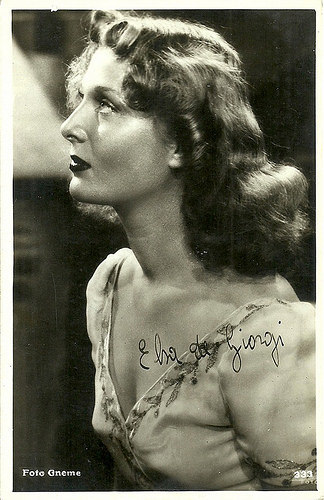
Italian postcard by Stab. Angeli, Terni, Ditta Terzoli, Roma, no. 333 Photo: Gneme.
Notorious Love Letters
Elsa De Giorgi had a prolific career in the Italian cinema under Mussolini, but her anti-fascism (notable is her description in her book I coetanei of her quarrel with Fascist minister Alessandro Pavolini) did not make her love acting in the regime’s films. Instead, she preferred working for the theatre.
In the post-war era, she would mostly perform on stage with directors such as Giorgio Strehler and Luchino Visconti. In 1949 Visconti called her to be Helen of Troy in his staging of William Shakespeare’s Troilus and Cressida at the Boboli gardens in Florence, during the Maggio Musicale. In 1957 she played Madame Roland in Giacobini by Federico Zardi, staged at the Teatro Piccolo in Milan by Giorgio Strehler.
She was married to resistance fighter and war hero, Count Sandrino Contini Bonacossi, who was the wealthy son of a renowned art merchant. In the second half of the 1950s and during her marriage with the Florentine aristocrat, she had a relationship with the writer Italo Calvino, described in her book Ho visto partire il tuo treno (I've Seen Your Train Leaving, 1992).
In 1955 she published I coetanei, a public diary with many references to the partisan struggle (with a tribute to her husband Sandrino) and to the Roman cinema of the period around the war. It won her the Premio Viareggio but it also lead to her relationship with Calvino, who was text editor for her book.
In the early sixties, she collaborated as theatre critic to the Roman paper Il Pensiero Nazionale.
She had a small part in Pier Paolo Pasolini’s short film La ricotta (1963). In 1975, she interpreted Ms. Maggi, one of the narrators of Salò o le 120 giornate di Sodoma/Salò, or the 120 days of Sodom (Pier Paolo Pasolini, 1975).
Her final screen credit was in the Alberto Sordi comedy Assolto per aver commesso il fatto/Acquitted for Having Committed the Deed(Alberto Sordi, 1993) in which she appeared briefly as a countess. Elsa De Giorgi died in Rome in 1997. She was 83.
In 2004, fragments were published of the some 400 (love) letters, which Italo Calvino wrote to her in the years of their affair (1955-1958) and which were kept by the University of Pavia. De Giorgi had sold the love letters to the archive in 1994, with the condition that they would not be opened for the following 25 years.
Still, a journalist could not wait and published excerpts in the Corriere della Sera, proving thus that the restrained, ironic writer had been a wildly passionate lover. Calvino’s widow, Chichita Calvino, was not amused and tried to prevent further publications. It also sparked a fierce debate between left and right on culture & politics and ownership of the media.
Furthermore, it became clear that Sandrino Contini Bonacossi, Elsa’s husband, who had suddenly disappeared in 1955 and was suspected of financial malversations, had instead left because he could not stand the triangular affair anymore. Afterwards he would divorce De Giorgi and disinherit her. Possibly this was the reason why De Giorgi eventually sold the letters in 1994.
In 1975, Sandrino Contini Bonacossi hung himself in New York. This seems to have no connection with De Giorgi’s affair with Calvino. In her book L'eredità Contini-Bonacossi, De Giorgi reconstructed the mysterious affair of clandestine export of art works, which had her husband as the main victim.
After his affair with Elsa De Giorgi, Italo Calvino wrote several novels with aristocrats in the title, such as The Cloven Viscount, The Baron in the Trees, and The Nonexistent Knight. De Giorgi claimed that the titles refer to her unfortunate husband and to her affair of Calvino, but this has been contested. While Elsa’s career dwindled, Calvino’s fame grew.
Italo Calvino died in 1985, twelve years before Elsa De Giorgi. After her death in 1997, the university of Pavia also acquired the 6000 volumes library of De Giorgi and her husband.
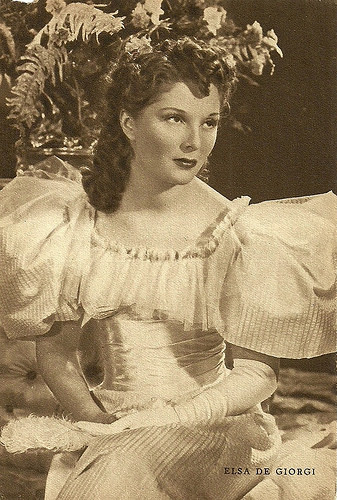
Italian postcard by Rizzoli, 1939.
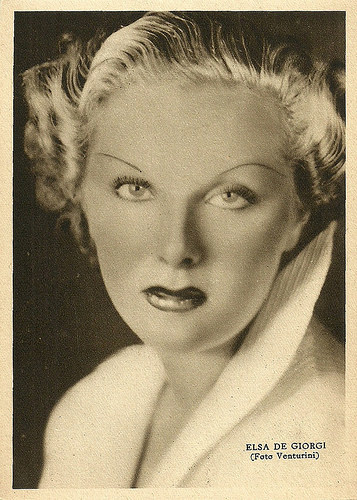
Italian postcard by Rizzoli, 1940. Photo: Venturini.
Sources: John Hooper (The Guardian), Biblioteca universitaria di Pavia (Italian), Frankfurter Algemeine (German), Wikipedia (Italian and English), and .

Italian postcard by Rizzoli, Milano, 1938. Photo: Tirrenia Film.

Italian postcard by Fotoluxardo, Roma. Publicity card for Melloni textiles, Bologna.
Ancient provincial aristocracy
Elsa De Giorgi was born Elsa Giorgi Alberti in 1914 in Pesaro. Her family was of ancient provincial aristocracy, the Giorgi Alberti’s, nobles of Bevagna and Camerino, patricians of Spoleto.
At the age of almost 18, she participated in a photographic competition. She was discovered by film director Mario Camerini, who offered her the role of the protagonist in T'amerò sempre/I will always love you (1933). In this film, a girl (De Giorgi) gives birth to a daughter but the father, a playboy (Mino Doro), has dumped her. Years after, they meet again, but there is also the girl’s colleague, an accountant (Nino Besozzi).
After this film debut, titles followed like the comedy L'impiegata di papà/Dad's clerk (Alessandro Blasetti, 1934) with Memo Benassi, the drama Porto/Port (Amleto Palermi, 1934) with Irma Grammatica and Camillo Pilotto , and Teresa Confalonieri/Loyalty of Love (Guido Brignone, 1934) with Marta Abba.
In the Luigi Pirandello adaptation Ma non è una cosa seria/But It's Nothing Serious (Mario Camerini, 1937) and La mazurca di papà/Daddy's mazurca (Oreste Biancoli 1938), she co-starred with Vittorio De Sica , and in La signora Paradiso (Enrico Guazzoni 1937), she had the lead role opposite Mino Doro and Memo Benassi.
Towards and during the war, De Giorgi often played in period pieces. This started with the lead role as Desirée Clary, Napoleon’s beloved in La sposa dei re/The Bride of the Kings (Duilio Coletti 1938) with Augusto Marcacci as Napoleon Bonaparte.
Other historical films with her are Il fornaretto di Venezia/The Fornaretto of Venice (Duilio Coletti, 1939) starring Roberto Villa as the unjustly accused, Capitan Fracassa/Captain Fracasse (Duilio Coletti, 1940) with Giorgio Costantini and Osvaldo Valenti, Fra' Diavolo/The Adventures of Fra Diavolo (Luigi Zampa, 1942) with Enzo Fiermonte, and La locandiera/The Innkeeper (Luigi Chiarini, 1944) starring Luisa Ferida .
In several of the wartime films De Giorgi was not allowed to have her own voice, and it was mainly Lydia Simoneschi who dubbed her.

Italian postcard by Stab. Angeli, Terni, Ditta Terzoli, Roma, no. 333 Photo: Gneme.
Notorious Love Letters
Elsa De Giorgi had a prolific career in the Italian cinema under Mussolini, but her anti-fascism (notable is her description in her book I coetanei of her quarrel with Fascist minister Alessandro Pavolini) did not make her love acting in the regime’s films. Instead, she preferred working for the theatre.
In the post-war era, she would mostly perform on stage with directors such as Giorgio Strehler and Luchino Visconti. In 1949 Visconti called her to be Helen of Troy in his staging of William Shakespeare’s Troilus and Cressida at the Boboli gardens in Florence, during the Maggio Musicale. In 1957 she played Madame Roland in Giacobini by Federico Zardi, staged at the Teatro Piccolo in Milan by Giorgio Strehler.
She was married to resistance fighter and war hero, Count Sandrino Contini Bonacossi, who was the wealthy son of a renowned art merchant. In the second half of the 1950s and during her marriage with the Florentine aristocrat, she had a relationship with the writer Italo Calvino, described in her book Ho visto partire il tuo treno (I've Seen Your Train Leaving, 1992).
In 1955 she published I coetanei, a public diary with many references to the partisan struggle (with a tribute to her husband Sandrino) and to the Roman cinema of the period around the war. It won her the Premio Viareggio but it also lead to her relationship with Calvino, who was text editor for her book.
In the early sixties, she collaborated as theatre critic to the Roman paper Il Pensiero Nazionale.
She had a small part in Pier Paolo Pasolini’s short film La ricotta (1963). In 1975, she interpreted Ms. Maggi, one of the narrators of Salò o le 120 giornate di Sodoma/Salò, or the 120 days of Sodom (Pier Paolo Pasolini, 1975).
Her final screen credit was in the Alberto Sordi comedy Assolto per aver commesso il fatto/Acquitted for Having Committed the Deed(Alberto Sordi, 1993) in which she appeared briefly as a countess. Elsa De Giorgi died in Rome in 1997. She was 83.
In 2004, fragments were published of the some 400 (love) letters, which Italo Calvino wrote to her in the years of their affair (1955-1958) and which were kept by the University of Pavia. De Giorgi had sold the love letters to the archive in 1994, with the condition that they would not be opened for the following 25 years.
Still, a journalist could not wait and published excerpts in the Corriere della Sera, proving thus that the restrained, ironic writer had been a wildly passionate lover. Calvino’s widow, Chichita Calvino, was not amused and tried to prevent further publications. It also sparked a fierce debate between left and right on culture & politics and ownership of the media.
Furthermore, it became clear that Sandrino Contini Bonacossi, Elsa’s husband, who had suddenly disappeared in 1955 and was suspected of financial malversations, had instead left because he could not stand the triangular affair anymore. Afterwards he would divorce De Giorgi and disinherit her. Possibly this was the reason why De Giorgi eventually sold the letters in 1994.
In 1975, Sandrino Contini Bonacossi hung himself in New York. This seems to have no connection with De Giorgi’s affair with Calvino. In her book L'eredità Contini-Bonacossi, De Giorgi reconstructed the mysterious affair of clandestine export of art works, which had her husband as the main victim.
After his affair with Elsa De Giorgi, Italo Calvino wrote several novels with aristocrats in the title, such as The Cloven Viscount, The Baron in the Trees, and The Nonexistent Knight. De Giorgi claimed that the titles refer to her unfortunate husband and to her affair of Calvino, but this has been contested. While Elsa’s career dwindled, Calvino’s fame grew.
Italo Calvino died in 1985, twelve years before Elsa De Giorgi. After her death in 1997, the university of Pavia also acquired the 6000 volumes library of De Giorgi and her husband.

Italian postcard by Rizzoli, 1939.

Italian postcard by Rizzoli, 1940. Photo: Venturini.
Sources: John Hooper (The Guardian), Biblioteca universitaria di Pavia (Italian), Frankfurter Algemeine (German), Wikipedia (Italian and English), and .
Published on January 21, 2018 22:00
January 20, 2018
Gina Lollobrigida
Italian actress and photojournalist Gina Lollobrigida (1927) was one of Europe’s most prominent film stars of the 1950s. ‘La Lollo’ was the first European sex symbol of the post war years and she paved the way into Hollywood for her younger colleagues Sophia Loren, Claudia Cardinale and Monica Bellucci.
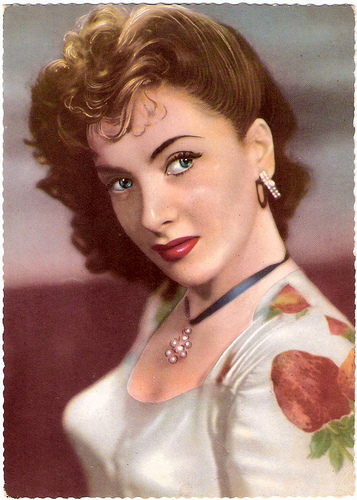
I.F.P.A. postcard, no. 15.
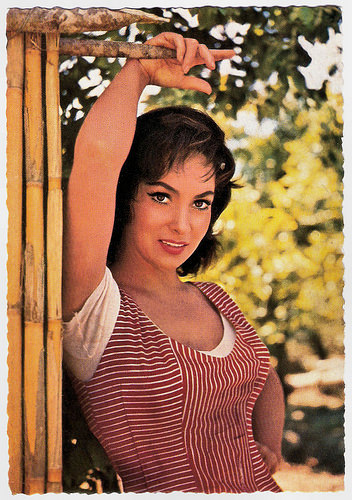
German postcard by Terra-Color, no. F 130. Photo: Morris, Rome.
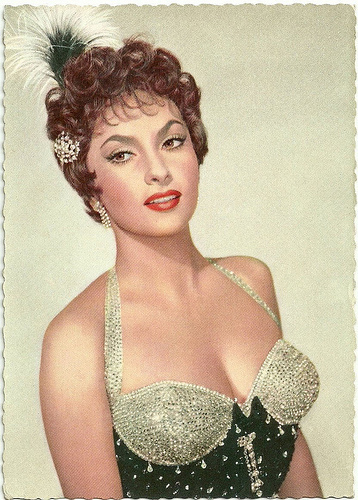
German postcard by Ufa, no. CK 67. Photo: Raymond Vainquel. Publicity still for Trapeze (Carol Reed, 1956).
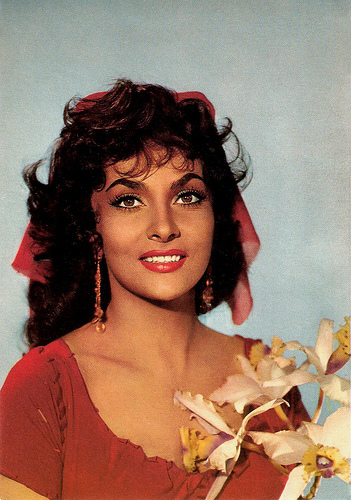
French postcard by E.D.U.G., no. 10. Photo: publicity still for Notre-Dame de Paris/The Hunchback of Notre Dame (Jean Delannoy, 1956).
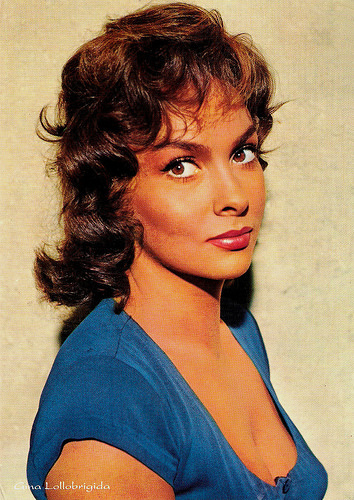
Italian postcard by Rotalfoto in the Artisti di Sempre series, no. 294.
The most beautiful toddler of Italy
Luigina Lollobrigida was born in the picturesque Italian mountain village Subiaco in 1927, as one of four daughters of a furniture manufacturer. At the age of 3, Luigina was already selected as the most beautiful toddler of Italy and in her youth she started to model.
She became an art student and made her film debut in an uncredited bit role in the adventure film Aquila nera/The Black Eagle Returns (Riccardo Freda, 1946) starring Rossano Brazzi .
In 1947, she entered the Miss Italia pageant and came in third. The contest was won by Lucia Bosé and second was Gianna Maria Canale . Both also became film actresses, though not nearly as successful as Lollobrigida.
Gina Lollobrigida was discovered by director Mario Costa who gave her a small part as a girlfriend of Adina ( Nelly Corradi ) in the opera adaptation L’elisir d’amore/Elixir of Love (Mario Costa, 1946).
Lollobrigida started to model as Diana Loris for the Fotoromanzi, the popular Italian photo novels.
She got her first bigger film part in another opera film, Pagliacci/Love of a Clown - Pagliacci (Mario Costa, 1948), co-starring with one of the greatest Italian baritones, Tito Gobbi. The film, based on Ruggero Leoncavallo's opera Pagliacci recounts the tragedy of Canio (Afro Poli), the lead clown (or pagliaccio in Italian) in a Commedia dell'arte troupe, his wife Nedda (Lollobrigida), and her lover,
Silvio (Gobbi).
When Nedda spurns the advances of Tonio (also Gobbi), another player in the troupe, he tells Canio about Nedda's betrayal. In a jealous rage, Canio murders both Nedda and Silvio. Lollobrigida's singing in this film was dubbed.
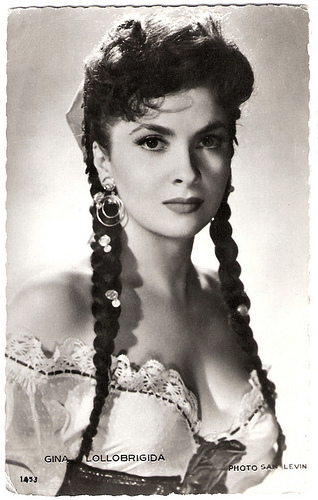
French postcard by Editions P.I., Paris, no. 29 F. Offered by Les Carbones Korès Carboplane. Photo: Sam Lévin. Publicity still for Fanfan la Tulipe/Fan-Fan the Tulip (Christian Jacque, 1952).
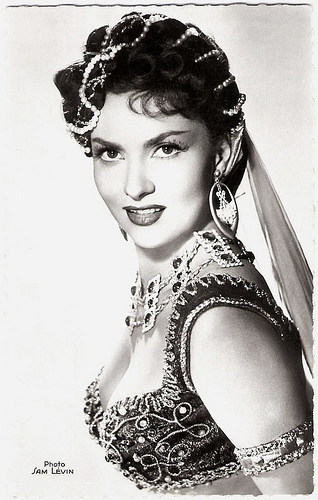
French postcard by Editions du Globe, Paris, no. 325. Photo: Sam Lévin. Publicity still for Les belles de nuit/Beauties of the Night (René Clair, 1952).
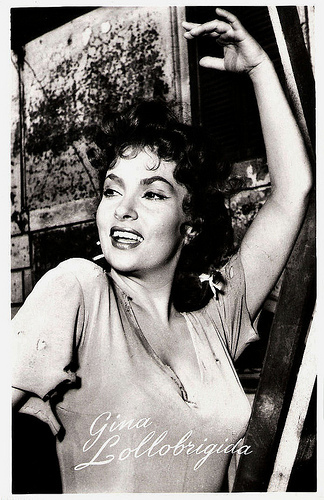
Dutch postcard by Uitg. Takken, Utrecht, no. 1748. Photo: publicity still for Pane, amore e fantasia/Bread, Love and Dreams (Luigi Comencini, 1953).
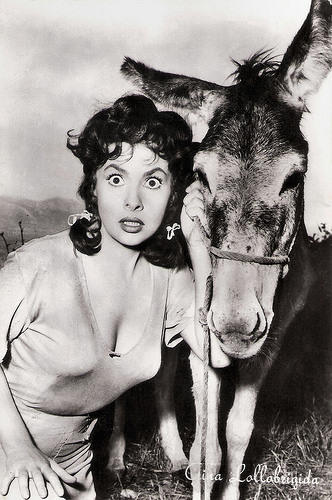
Yugoslavian postcard by NPO, no. G5. Photo: pubicity still for Pane, amore e fantasia/Bread, Love and Dreams (Luigi Comencini, 1953).
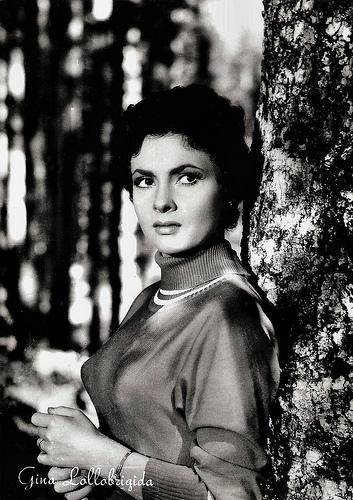
Italian postcard by Rotalfoto, Milano, no. 187. Photo: Ponti / De Laurentiis. Publicity still for La provinciale/The Wayward Wife (Mario Soldati, 1953).
Miss Italia
Gina Lollobtrigida's first major success as a leading lady was in Miss Italia/My Beautiful Daughter (Duilio Coletti, 1950), a backstage drama set at a beauty contest.
It was followed by the delightful comedy Vita da cani/A Dog's Life (Mario Monicelli, Steno, 1950) with Aldo Fabrizi, and the award winning crime drama La città si difende/Four Ways Out (Pietro Germi, 1951), based on a script by Federico Fellini.
In France she co-starred with Gérard Philipe in the hugely entertaining melange of swash-buckling adventure, comedy and romance Fanfan la Tulipe/Fan-Fan the Tulip (Christian Jacque, 1952) and in Les Belles de Nuit/Beauties of the Night (René Clair, 1952).
James Travers at Films de France : "As French matinee idol Gérard Philipe is propelled through history and cardboard Freudian dreamscapes, into the arms of such beauties as Martine Carol and Gina Lollobrigida, (director René) Clair appears to have all but lost his tenuous grip on reality (the scene with the dinosaur confirms it) - but who cares? This is a film which, like Clair’s earlier comic masterpieces, is intended to distract and entertain, and it does that marvellously and unashamedly."
Gina Lollobrigida had her definitive breakthrough with the huge global hit Pane, amore e fantasia/Bread, Love and Dreams (Luigi Comencini, 1953), in which she starred with Vittorio De Sica .
This romantic comedy was nominated in the U.S. for an Oscar, and Lollobrigida herself received in Great Britain a nomination at BAFTA. The success led to three sequels, including Pane, amore e gelosia/Bread, Love and Jealousy (Luigi Comencini, 1954).
Her first American film was Beat the Devil (John Huston, 1953). She was at her best as Humphrey Bogart's wife in this odd but endearing noiresque comedy.
Next she earned her nickname ‘The World's Most Beautiful Woman’ for her signature film La donna più bella del mondo (Robert Z. Leonard, 1956), in which she played the legendary actress Lina Cavalieri .
For her role in this film she received the first David di Donatello for Best Actress. Her earthy looks and short 'tossed salad' hairdo were quite influential, and in fact there's a type of curly lettuce named 'Lollo' in honour of her cute hairdo. (In France 'Lollo's' were a nickname for breasts).
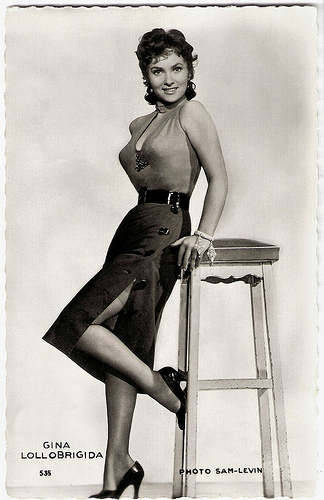
French postcard by Editions P.I., Paris, no. 29 F. Offered by Les Carbones Korès Carboplane. Photo: Sam Lévin.
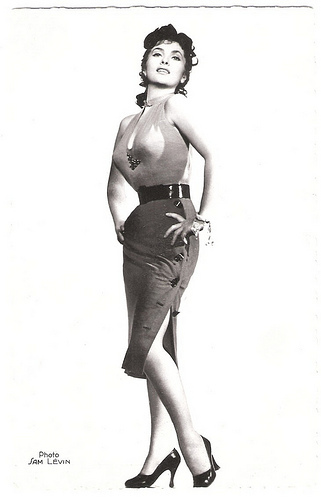
French postcard by Editions du Globe (E.D.U.G.), Paris, no. 360. Photo: Sam Lévin.
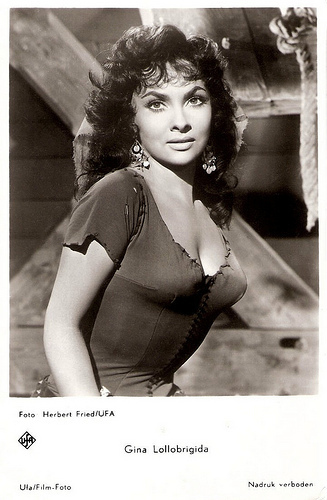
Dutch postcard by Gebr. Spanjersberg, no. 354. Photo: Herbert Fried / Ufa. Publicity still for Notre Dame de Paris (1956).
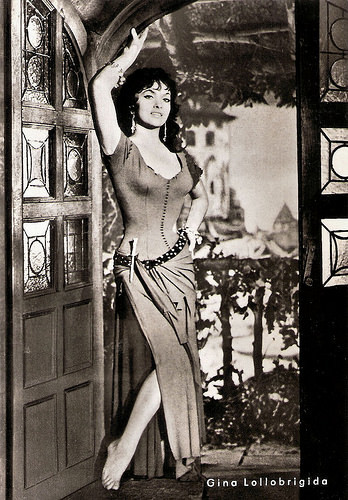
East-German postcard by VEB Progress Film-Vertrieb, Berlin, no. 2/72. Photo: publicity still for Notre-Dame de Paris/The Hunchback of Notre Dame (Jean Delannoy, 1956).
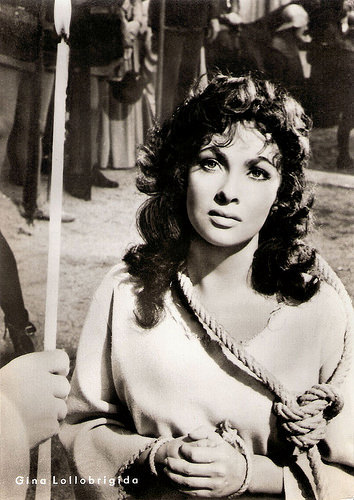
East-German postcard by VEB Progress Film-Vertrieb, Berlin, no. 56/72. Photo: publicity still for Notre-Dame de Paris/The Hunchback of Notre Dame (Jean Delannoy, 1956).
Esmeralda
Gina Lollobrigida made another Hollywood appearance in the circus melodrama Trapeze (Carol Reed, 1956) between Burt Lancaster and Tony Curtis.
Next she starred as Esmeralda in Notre Dame de Paris/The Hunchback of Notre Dame (Jean Delannoy, 1956) opposite Anthony Quinn as Quasimodo.
In 1959 she lured Yul Brynner in the Biblical epic Solomon and Sheba (King Vidor, 1959).
One of her most popular Hollywood films was Come September (Robert Mulligan, 1961), in which she played the never-contented mistress of Rock Hudson. For this lightweight comedy she won the Golden Globe as 'World Film Favorite'.
She co-starred again with Hudson in Strange Bedfellows (Melvin Frank, 1965) and in 1968 she starred in the enjoyable screwball comedy Buona Sera, Mrs. Campbell (Melvin Frank, 1968), for which she was again nominated for a Golden Globe and won a David di Donatello award, the Italian Oscar.
On TV, Gina Lollobrigida was seen in the mini series Le Avventure di Pinocchio/The Adventures of Pinocchio (Luigi Comencini, 1972).
She retired from acting in the mid-1970s, but has occasionally returned for the camera, including in a regular role in the American soap opera Falcon Crest (1984).
She has used her celebrity to sell cosmetics, published two books of her photography, Italia (My Italy, 1973) and Wonder of Innocence (1994), and created sculptures.
In the mid-1970s she wrote, directed and produced Ritratto di Fidel/Portrait of Fidel, a very personal 50-minute documentary about Fidel Castro that included a rare interview with the Cuban dictator, fuelling persistent rumours that a romance was sparked.
In 1986, she was the head of jury at the Berlin International Film Festival, and in 1999 she ran for a seat in the European Union Parliament, stressing humanitarian issues, but she lost the election.
Now virtually retired, Gina Lollobrigida has not made a film appearance since XXL (Ariel Zeitoun, 1997) with Gérard Depardieu .
Gina Lollobrigida was married once, to Slovenian physician Milko Skofic, in 1949. Skofic gave up his practise to become her manager. They had one child, Milko Skofic, Jr., born in 1957, and the couple divorced in 1971. In 1993 her grandson Dimitri was born.
Lollobrigida has lived since 1949 at her home ranch and gardens in Sicily. The property contains her personal museum. In addition, she regularly stays at her house on Via Appia Antica in Rome and at a villa in Monte Carlo. Since 2009 Lollobrigida has not allowed visitors to her home. In 2013, Lollobrigida sold her jewelry collection through Sotheby's. She donated nearly $5 million to benefit stem cell therapy.
Next to her Golden Globe, Lollobrigida has won 6 David di Donatello, 2 Nastro d'Argento, and 6 Bambi Awards. In 1985 she was nominated as an Officier of the Ordre des Arts et des Lettres by the French Minister of Culture, Jack Lang for her achievements in sculpture and in photography. In 1992 she was awarded the Légion d'Honneur by president François Mitterrand.
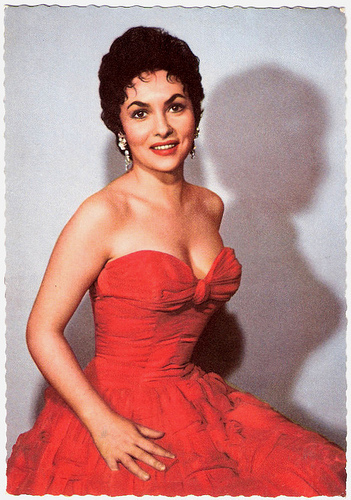
German postcard by Universum-Film Aktiengesellschaft, Berlin-Tempelhof (Ufa), no. CK-157. Retail price: 30 Pfg. Photo: Camerapress.
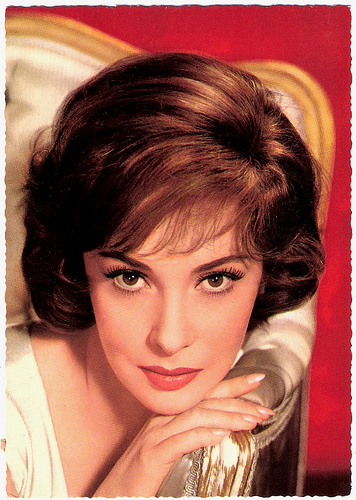
German postcard by Krüger, no. 902/135. Photo: Universal / Ufa.
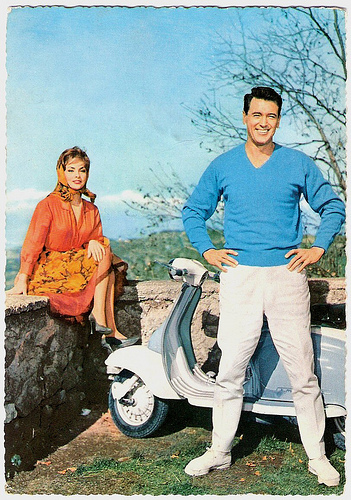
German postcard by Krüger, no. 902/129. Photo: Terb Agency / Ufa. Publicity still for Come September (Robert Mulligan, 1961) with Rock Hudson.
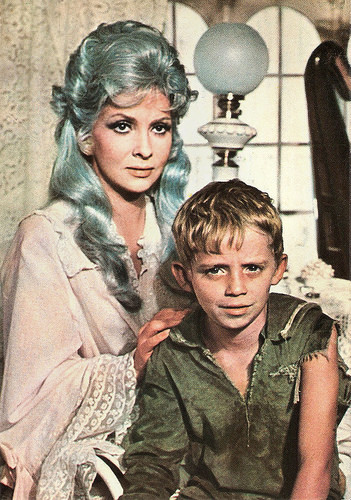
Italian postcard by Edizioni Panini, Modena (EPM). Photo: Sampaolofilm / Cinepat. Publicity still for Le avventure di Pinocchio/The Adventures of Pinocchio (Luigi Comencini, 1972) with Andrea Balestri. Caption: The Fairy and the boy Pinocchio.
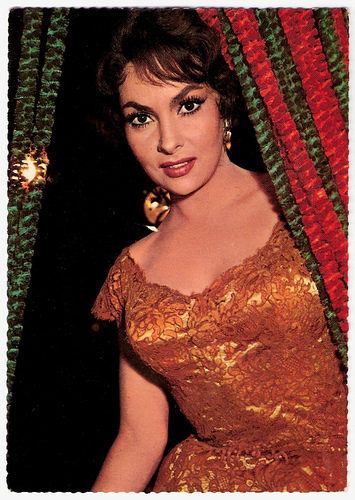
German postcard by Krüger, no. 902/56. Photo: Farabola.
Sources: James Travers (Film de France), NNDB, Andrea LeVasseur (AllMovie), (IMDb), Wikipedia, and .

I.F.P.A. postcard, no. 15.

German postcard by Terra-Color, no. F 130. Photo: Morris, Rome.

German postcard by Ufa, no. CK 67. Photo: Raymond Vainquel. Publicity still for Trapeze (Carol Reed, 1956).

French postcard by E.D.U.G., no. 10. Photo: publicity still for Notre-Dame de Paris/The Hunchback of Notre Dame (Jean Delannoy, 1956).

Italian postcard by Rotalfoto in the Artisti di Sempre series, no. 294.
The most beautiful toddler of Italy
Luigina Lollobrigida was born in the picturesque Italian mountain village Subiaco in 1927, as one of four daughters of a furniture manufacturer. At the age of 3, Luigina was already selected as the most beautiful toddler of Italy and in her youth she started to model.
She became an art student and made her film debut in an uncredited bit role in the adventure film Aquila nera/The Black Eagle Returns (Riccardo Freda, 1946) starring Rossano Brazzi .
In 1947, she entered the Miss Italia pageant and came in third. The contest was won by Lucia Bosé and second was Gianna Maria Canale . Both also became film actresses, though not nearly as successful as Lollobrigida.
Gina Lollobrigida was discovered by director Mario Costa who gave her a small part as a girlfriend of Adina ( Nelly Corradi ) in the opera adaptation L’elisir d’amore/Elixir of Love (Mario Costa, 1946).
Lollobrigida started to model as Diana Loris for the Fotoromanzi, the popular Italian photo novels.
She got her first bigger film part in another opera film, Pagliacci/Love of a Clown - Pagliacci (Mario Costa, 1948), co-starring with one of the greatest Italian baritones, Tito Gobbi. The film, based on Ruggero Leoncavallo's opera Pagliacci recounts the tragedy of Canio (Afro Poli), the lead clown (or pagliaccio in Italian) in a Commedia dell'arte troupe, his wife Nedda (Lollobrigida), and her lover,
Silvio (Gobbi).
When Nedda spurns the advances of Tonio (also Gobbi), another player in the troupe, he tells Canio about Nedda's betrayal. In a jealous rage, Canio murders both Nedda and Silvio. Lollobrigida's singing in this film was dubbed.

French postcard by Editions P.I., Paris, no. 29 F. Offered by Les Carbones Korès Carboplane. Photo: Sam Lévin. Publicity still for Fanfan la Tulipe/Fan-Fan the Tulip (Christian Jacque, 1952).

French postcard by Editions du Globe, Paris, no. 325. Photo: Sam Lévin. Publicity still for Les belles de nuit/Beauties of the Night (René Clair, 1952).

Dutch postcard by Uitg. Takken, Utrecht, no. 1748. Photo: publicity still for Pane, amore e fantasia/Bread, Love and Dreams (Luigi Comencini, 1953).

Yugoslavian postcard by NPO, no. G5. Photo: pubicity still for Pane, amore e fantasia/Bread, Love and Dreams (Luigi Comencini, 1953).

Italian postcard by Rotalfoto, Milano, no. 187. Photo: Ponti / De Laurentiis. Publicity still for La provinciale/The Wayward Wife (Mario Soldati, 1953).
Miss Italia
Gina Lollobtrigida's first major success as a leading lady was in Miss Italia/My Beautiful Daughter (Duilio Coletti, 1950), a backstage drama set at a beauty contest.
It was followed by the delightful comedy Vita da cani/A Dog's Life (Mario Monicelli, Steno, 1950) with Aldo Fabrizi, and the award winning crime drama La città si difende/Four Ways Out (Pietro Germi, 1951), based on a script by Federico Fellini.
In France she co-starred with Gérard Philipe in the hugely entertaining melange of swash-buckling adventure, comedy and romance Fanfan la Tulipe/Fan-Fan the Tulip (Christian Jacque, 1952) and in Les Belles de Nuit/Beauties of the Night (René Clair, 1952).
James Travers at Films de France : "As French matinee idol Gérard Philipe is propelled through history and cardboard Freudian dreamscapes, into the arms of such beauties as Martine Carol and Gina Lollobrigida, (director René) Clair appears to have all but lost his tenuous grip on reality (the scene with the dinosaur confirms it) - but who cares? This is a film which, like Clair’s earlier comic masterpieces, is intended to distract and entertain, and it does that marvellously and unashamedly."
Gina Lollobrigida had her definitive breakthrough with the huge global hit Pane, amore e fantasia/Bread, Love and Dreams (Luigi Comencini, 1953), in which she starred with Vittorio De Sica .
This romantic comedy was nominated in the U.S. for an Oscar, and Lollobrigida herself received in Great Britain a nomination at BAFTA. The success led to three sequels, including Pane, amore e gelosia/Bread, Love and Jealousy (Luigi Comencini, 1954).
Her first American film was Beat the Devil (John Huston, 1953). She was at her best as Humphrey Bogart's wife in this odd but endearing noiresque comedy.
Next she earned her nickname ‘The World's Most Beautiful Woman’ for her signature film La donna più bella del mondo (Robert Z. Leonard, 1956), in which she played the legendary actress Lina Cavalieri .
For her role in this film she received the first David di Donatello for Best Actress. Her earthy looks and short 'tossed salad' hairdo were quite influential, and in fact there's a type of curly lettuce named 'Lollo' in honour of her cute hairdo. (In France 'Lollo's' were a nickname for breasts).

French postcard by Editions P.I., Paris, no. 29 F. Offered by Les Carbones Korès Carboplane. Photo: Sam Lévin.

French postcard by Editions du Globe (E.D.U.G.), Paris, no. 360. Photo: Sam Lévin.

Dutch postcard by Gebr. Spanjersberg, no. 354. Photo: Herbert Fried / Ufa. Publicity still for Notre Dame de Paris (1956).

East-German postcard by VEB Progress Film-Vertrieb, Berlin, no. 2/72. Photo: publicity still for Notre-Dame de Paris/The Hunchback of Notre Dame (Jean Delannoy, 1956).

East-German postcard by VEB Progress Film-Vertrieb, Berlin, no. 56/72. Photo: publicity still for Notre-Dame de Paris/The Hunchback of Notre Dame (Jean Delannoy, 1956).
Esmeralda
Gina Lollobrigida made another Hollywood appearance in the circus melodrama Trapeze (Carol Reed, 1956) between Burt Lancaster and Tony Curtis.
Next she starred as Esmeralda in Notre Dame de Paris/The Hunchback of Notre Dame (Jean Delannoy, 1956) opposite Anthony Quinn as Quasimodo.
In 1959 she lured Yul Brynner in the Biblical epic Solomon and Sheba (King Vidor, 1959).
One of her most popular Hollywood films was Come September (Robert Mulligan, 1961), in which she played the never-contented mistress of Rock Hudson. For this lightweight comedy she won the Golden Globe as 'World Film Favorite'.
She co-starred again with Hudson in Strange Bedfellows (Melvin Frank, 1965) and in 1968 she starred in the enjoyable screwball comedy Buona Sera, Mrs. Campbell (Melvin Frank, 1968), for which she was again nominated for a Golden Globe and won a David di Donatello award, the Italian Oscar.
On TV, Gina Lollobrigida was seen in the mini series Le Avventure di Pinocchio/The Adventures of Pinocchio (Luigi Comencini, 1972).
She retired from acting in the mid-1970s, but has occasionally returned for the camera, including in a regular role in the American soap opera Falcon Crest (1984).
She has used her celebrity to sell cosmetics, published two books of her photography, Italia (My Italy, 1973) and Wonder of Innocence (1994), and created sculptures.
In the mid-1970s she wrote, directed and produced Ritratto di Fidel/Portrait of Fidel, a very personal 50-minute documentary about Fidel Castro that included a rare interview with the Cuban dictator, fuelling persistent rumours that a romance was sparked.
In 1986, she was the head of jury at the Berlin International Film Festival, and in 1999 she ran for a seat in the European Union Parliament, stressing humanitarian issues, but she lost the election.
Now virtually retired, Gina Lollobrigida has not made a film appearance since XXL (Ariel Zeitoun, 1997) with Gérard Depardieu .
Gina Lollobrigida was married once, to Slovenian physician Milko Skofic, in 1949. Skofic gave up his practise to become her manager. They had one child, Milko Skofic, Jr., born in 1957, and the couple divorced in 1971. In 1993 her grandson Dimitri was born.
Lollobrigida has lived since 1949 at her home ranch and gardens in Sicily. The property contains her personal museum. In addition, she regularly stays at her house on Via Appia Antica in Rome and at a villa in Monte Carlo. Since 2009 Lollobrigida has not allowed visitors to her home. In 2013, Lollobrigida sold her jewelry collection through Sotheby's. She donated nearly $5 million to benefit stem cell therapy.
Next to her Golden Globe, Lollobrigida has won 6 David di Donatello, 2 Nastro d'Argento, and 6 Bambi Awards. In 1985 she was nominated as an Officier of the Ordre des Arts et des Lettres by the French Minister of Culture, Jack Lang for her achievements in sculpture and in photography. In 1992 she was awarded the Légion d'Honneur by president François Mitterrand.

German postcard by Universum-Film Aktiengesellschaft, Berlin-Tempelhof (Ufa), no. CK-157. Retail price: 30 Pfg. Photo: Camerapress.

German postcard by Krüger, no. 902/135. Photo: Universal / Ufa.

German postcard by Krüger, no. 902/129. Photo: Terb Agency / Ufa. Publicity still for Come September (Robert Mulligan, 1961) with Rock Hudson.

Italian postcard by Edizioni Panini, Modena (EPM). Photo: Sampaolofilm / Cinepat. Publicity still for Le avventure di Pinocchio/The Adventures of Pinocchio (Luigi Comencini, 1972) with Andrea Balestri. Caption: The Fairy and the boy Pinocchio.

German postcard by Krüger, no. 902/56. Photo: Farabola.
Sources: James Travers (Film de France), NNDB, Andrea LeVasseur (AllMovie), (IMDb), Wikipedia, and .
Published on January 20, 2018 22:00
January 19, 2018
Angelo Ferrari
Italian actor Angelo Ferrari (1897-1945) appeared in nearly 200 films. He started his career in Italian silent films and later got a strong foothold in the German cinema.
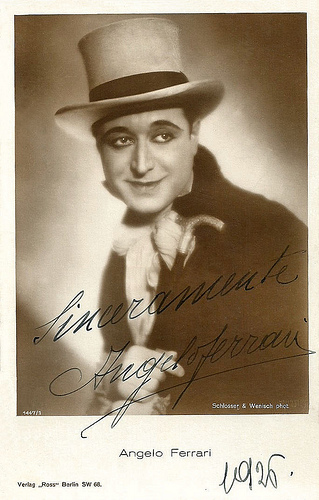
German postcard by Ross Verlag, no. 1447/1, 1926-1928. Photo: Schlosser & Wenisch. Signed: 'Sinceramente [Sincerely], Angelo Ferrari. 1926.'
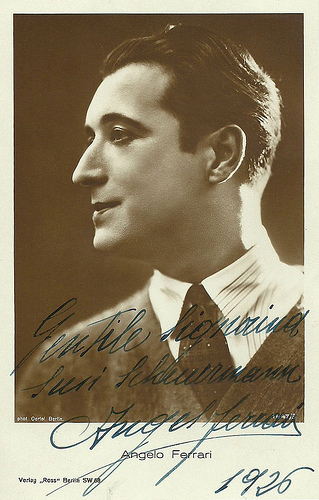
German postcard by Ross Verlag, no. 1447/3, 1926-1928. Photo: Oertel, Berlin. Signed: 'Gentile signorina Susi Schuurmann, Angelo Ferrari. 1926.'
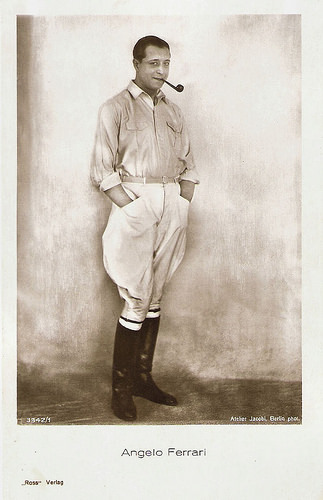
German postcard by Ross Verlag, no. 3342/1, 1928-1929. Photo: Atelier Jacobi, Berlin.
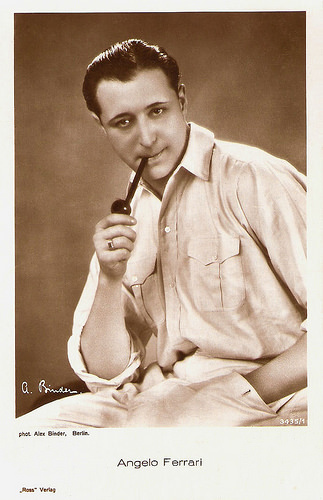
German postcard by Ross Verlag, no. 3435/1, 1928-1929. Photo: Alex Binder, Berlin.
Love-is-stronger-than-death Story
Angelo Ferrari was born in Fara Gera d’Adda in Lombardia, Italy in 1897. In 1913 and 1914, the young Ferrari became roll skate champion in Italy.
Thomas Staedeli at Cyranos : "Ferrari was spotted by the actress Diana Karenne ". She provided the role of a prince for him in the silent film Sofia di Kravonia (Ernesto Maria Pasquali, 1916).
In the late 1910s, he continued with Italian silent films like La serata d'onore di Buffalo/The Gala Night for Buffalo (Carlo Campogalliani, 1916) and Il veliero della morte/The Veil of Death (Carlo Campogalliani, 1917). These films were all produced by the pioneering production company Pasquali Film.
After doing military service between 1916 and 1918, Ferrari worked with well-known director Augusto Genina on I tre sentimentali/The Three Sentimentals (1920), L'incatenata/The Chained Woman (1921) and Un punto nero/The Black Point (1922).
Ferrari starred with diva Francesca Bertini inthe drama La donna nuda/The Naked Woman (1922), based on a play by Henry Bataille. The film was directed by Roberto Roberti – Sergio Leone’s father,
With another Italian diva, Rina De Liguoro , he appeared in Savitri Satyavan (Giorgio Mannini, 1923). This was the first international co-production of India. The love-is-stronger-than-death story sees Savitri (De Liguoro), the daughter of King Ashwapati and a goddess, fall for Satyavan (Ferrari) who is destined to die within a year. He is killed by a tree and his soul is gathered by the god Yama (Gianna Terribili-Gonzales) but he returns to life and there is a happy ending for the lovers. Some nudity and other 'erotic' images were removed in India to satisfy the censors.
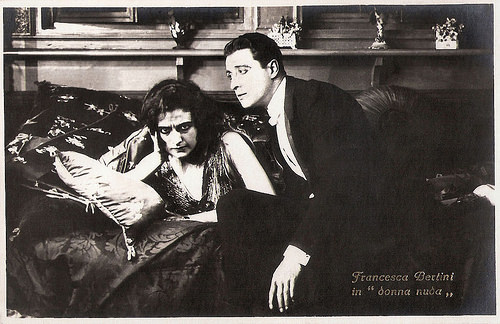
Italian postcard by G.B. Falci, Milano, no. 107. Photo: La Fotominio. Publicity still for La donna nuda/The naked woman (Roberto Roberti, 1922) with Francesca Bertini .
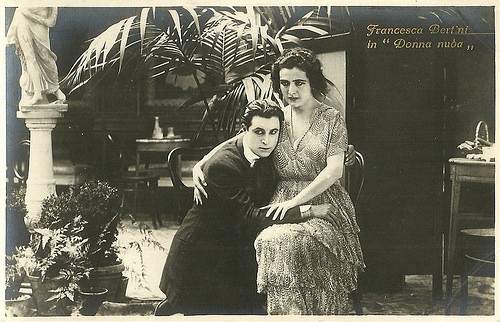
Italian postcard by G.B. Falci, Milano, no. 115. Photo: La Fotominio. Publicity still for La donna nuda/The naked woman (Roberto Roberti, 1922) with Francesca Bertini .

Italian postcard. Photo: UCI. Publicity still for the Franco-Italian historical film Cirano di Bergerac/Cyrano de Bergerac (Augusto Genina, 1923), based on Edmond Rostand's famous play Cyrano de Bergerac. Caption: the nice phrases of Christian he learned from Cyrano have conquered and seduced Roxane. Linda Moglia played Roxanne.
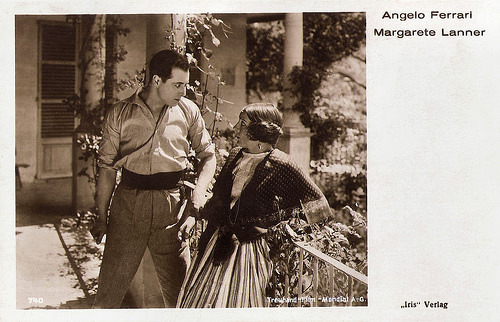
Austrian postcard by Iris Verlag, no. 740. Photo: Treuhand-Film / Mondial A.G. Publicity still for In Treue stark/In faithful strong (Heinrich Brandt, 1926) with Margarete Lanner .
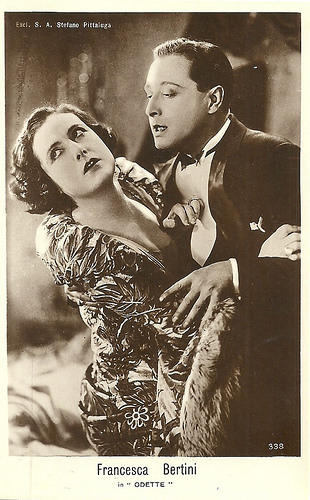
Italian postcard, no. 338. Photo: S.A. Stefano Pittaluga. Francesca Bertini and Angelo Ferrari in Mein Leben für das Deine/Odette (Luitz-Morat, 1928), based on Victorien Sardou's play Odette, and released in Italy under the same title. Bertini had already played in 1916 in an Italian version of Odette and would do it again in the sound era in a French version of Odette (1935).
France, Germany, Italy
Angelo Ferrari appeared with Geneviève Félix in the French production L'engrenage/The gear (Maurice Kéroul, Max Reichmann, 1923) before gaining a foothold in the German film business.
His breakthrough role in Germany was as an elegant count in the drama Die grüne Manuela/The Green Manuela (Ewald André Dupont, 1923). The film's plot bears a number of similarities to Carmen. Lucie Labass played a gypsy dancer, who becomes involved with Spanish smugglers. It was the first time director Dupont worked with the cinematographer Werner Brandes and the art director Alfred Junge who were to become important collaborators with him.
In the silent German cinema, Ferrari acted in successful films like Prater (Peter Paul Felner, 1924) with Henny Porten , Die Motorbraut/The Motor Bride (Richard Eichberg, 1925) with Lee Parry , and the Kammerspiel Eifersucht/Jealousy (Karl Grune, 1925) opposite Lya de Putti .
He returned to Italy for another hit, Cirano di Bergerac/Cyrano de Bergerac (Augusto Genina, 1925), a film version of Edmond Rostand's famous play. He played the handsome Christian, who is eager to declare his love for the fair Roxanne ( Linda Moglia ), but he doesn't have the gift for words that Cyrano (Pierre Magnier) does.
In Germany he then appeared in dozens of films including Rosen aus dem Süden/Roses From the South (Carl Froelich, 1926) opposite Henny Porten , Orientexpress/Orient Express (Wilhelm Thiele, 1927 with Lil Dagover , and the comedy Kopf hoch, Charly!/Heads Up, Charley (Willi Wolff, 1927) with Marlene Dietrich in a supporting role.
Later followed Die Sünderin/The Sinner (Mario Bonnard, 1927) featuring Elisabeth Pinajeff , the German-Italian drama Villa Falconieri (Richard Oswald, 1928) with Maria Jacobini , and the war drama Richthofen (Peter Joseph, 1929). In his German films, Ferrari often played roles such as an officer, a marquis or a prince.
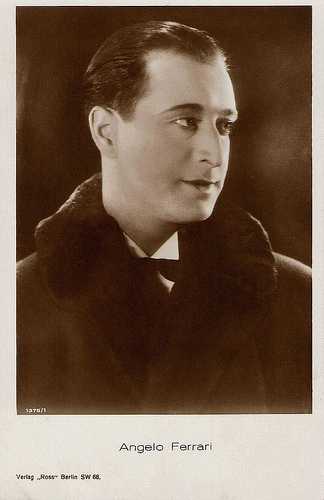
German postcard by Ross Verlag, no. 1376/1, 1927-1928.
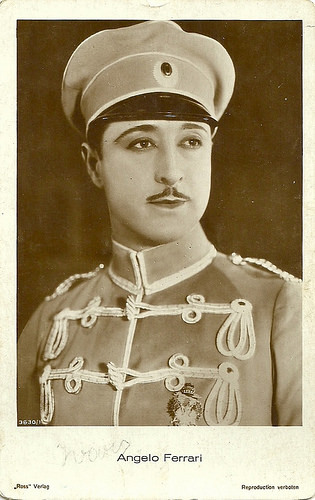
German postcard by Ross Verlag, no. 3630/1, 1928-1929.
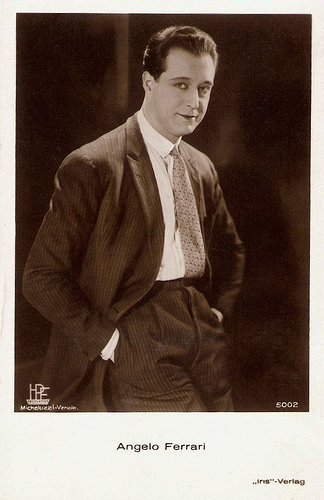
Austrian postcard by Iris-Verlag, no. 5002. Photo: HPF / Micheluzzi-Verleih.
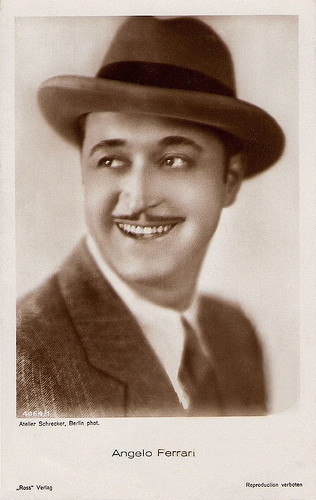
German postcard by Ross Verlag, no. 4064/1, 1929-1930. Photo: Atelier Schrecker, Berlin.
The Age of the Talkies
Angelo Ferrari’s first sound film was La donna di una notte/The Woman of One Night (Marcel L’Herbier, 1930) featuring the diva of the silent Italian cinema Francesca Bertini . It was an alternate language version of La femme d'une nuit (Marcel L’Herbier, 1930), also starring Bertini.
Because La donna di una notte was edited without his consent, director L'Herbier asked for his name to be removed from the credits. It was still released in Rome and Milan for Christmas of 1931 with his name still appearing.
In the age of the talkies, Ferrari continued to play in well-known German pictures like Barcarole (Gerhard Lamprecht, 1935), Fridericus (Johannes Meyer, 1936), Der Mann der Sherlock Holmes War/The Man Who Was Sherlock Holmes (Karl Hartl, 1937) starring Hans Albers and Heinz Rühmann , and Tango Notturno (Fritz Kirchhoff, 1937) featuring Pola Negri .
But his parts had become smaller because of his lack of the German language. During the 1940s, Ferrari appeared in more than 50 German films, mostly in small, sometimes even uncredited parts. Some of his films were finished and released after the end of war. The comedy Verlobte Leute/Engaged People, directed by Karl Anton and starring Axel von Ambesser, was filmed in 1945, but had its premiere in 1950 as Das Dementi in East-Germany.
Angelo Ferrari was already five years dead by then. After a stroke, he had died in Niederlehme, Germany in 1945, briefly before the end of World War II. He was 47. (Our sources differ about the details of his death. English Wikipedia e.g. writes that he died in Berlin in 1954, at the age of 66).
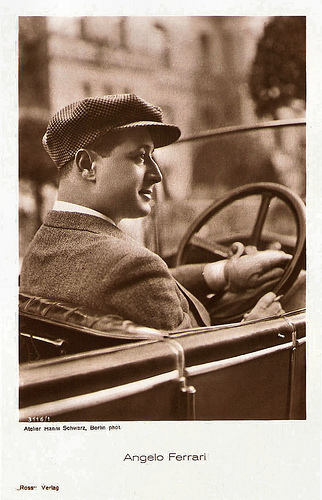
German postcard by Ross Verlag, no. 3116/1, 1928-1929. Photo: Atelier Hanni Schwarz.
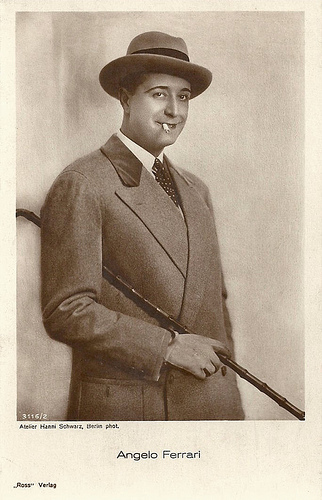
German postcard by Ross Verlag, no. 3116/2, 1928-1929. Photo: Atelier Hanni Schwarz, Berlin.
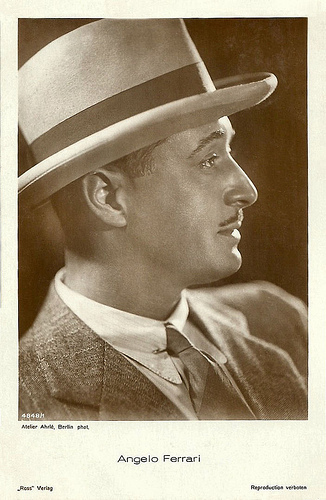
German postcard by Ross Verlag, no. 4848/1, 1929-1930. Photo: Atelier Ahrlé, Berlin.
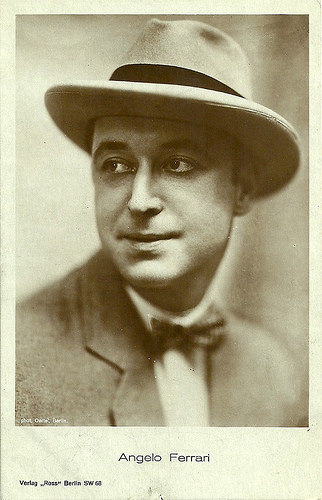
German postcard by Ross Verlag. Photo: Oertel, Berlin.
Sources: Thomas Staedeli (Cyranos), Janiss Garza (AllMovie), Wikipedia (English and German) and .

German postcard by Ross Verlag, no. 1447/1, 1926-1928. Photo: Schlosser & Wenisch. Signed: 'Sinceramente [Sincerely], Angelo Ferrari. 1926.'

German postcard by Ross Verlag, no. 1447/3, 1926-1928. Photo: Oertel, Berlin. Signed: 'Gentile signorina Susi Schuurmann, Angelo Ferrari. 1926.'

German postcard by Ross Verlag, no. 3342/1, 1928-1929. Photo: Atelier Jacobi, Berlin.

German postcard by Ross Verlag, no. 3435/1, 1928-1929. Photo: Alex Binder, Berlin.
Love-is-stronger-than-death Story
Angelo Ferrari was born in Fara Gera d’Adda in Lombardia, Italy in 1897. In 1913 and 1914, the young Ferrari became roll skate champion in Italy.
Thomas Staedeli at Cyranos : "Ferrari was spotted by the actress Diana Karenne ". She provided the role of a prince for him in the silent film Sofia di Kravonia (Ernesto Maria Pasquali, 1916).
In the late 1910s, he continued with Italian silent films like La serata d'onore di Buffalo/The Gala Night for Buffalo (Carlo Campogalliani, 1916) and Il veliero della morte/The Veil of Death (Carlo Campogalliani, 1917). These films were all produced by the pioneering production company Pasquali Film.
After doing military service between 1916 and 1918, Ferrari worked with well-known director Augusto Genina on I tre sentimentali/The Three Sentimentals (1920), L'incatenata/The Chained Woman (1921) and Un punto nero/The Black Point (1922).
Ferrari starred with diva Francesca Bertini inthe drama La donna nuda/The Naked Woman (1922), based on a play by Henry Bataille. The film was directed by Roberto Roberti – Sergio Leone’s father,
With another Italian diva, Rina De Liguoro , he appeared in Savitri Satyavan (Giorgio Mannini, 1923). This was the first international co-production of India. The love-is-stronger-than-death story sees Savitri (De Liguoro), the daughter of King Ashwapati and a goddess, fall for Satyavan (Ferrari) who is destined to die within a year. He is killed by a tree and his soul is gathered by the god Yama (Gianna Terribili-Gonzales) but he returns to life and there is a happy ending for the lovers. Some nudity and other 'erotic' images were removed in India to satisfy the censors.

Italian postcard by G.B. Falci, Milano, no. 107. Photo: La Fotominio. Publicity still for La donna nuda/The naked woman (Roberto Roberti, 1922) with Francesca Bertini .

Italian postcard by G.B. Falci, Milano, no. 115. Photo: La Fotominio. Publicity still for La donna nuda/The naked woman (Roberto Roberti, 1922) with Francesca Bertini .

Italian postcard. Photo: UCI. Publicity still for the Franco-Italian historical film Cirano di Bergerac/Cyrano de Bergerac (Augusto Genina, 1923), based on Edmond Rostand's famous play Cyrano de Bergerac. Caption: the nice phrases of Christian he learned from Cyrano have conquered and seduced Roxane. Linda Moglia played Roxanne.

Austrian postcard by Iris Verlag, no. 740. Photo: Treuhand-Film / Mondial A.G. Publicity still for In Treue stark/In faithful strong (Heinrich Brandt, 1926) with Margarete Lanner .

Italian postcard, no. 338. Photo: S.A. Stefano Pittaluga. Francesca Bertini and Angelo Ferrari in Mein Leben für das Deine/Odette (Luitz-Morat, 1928), based on Victorien Sardou's play Odette, and released in Italy under the same title. Bertini had already played in 1916 in an Italian version of Odette and would do it again in the sound era in a French version of Odette (1935).
France, Germany, Italy
Angelo Ferrari appeared with Geneviève Félix in the French production L'engrenage/The gear (Maurice Kéroul, Max Reichmann, 1923) before gaining a foothold in the German film business.
His breakthrough role in Germany was as an elegant count in the drama Die grüne Manuela/The Green Manuela (Ewald André Dupont, 1923). The film's plot bears a number of similarities to Carmen. Lucie Labass played a gypsy dancer, who becomes involved with Spanish smugglers. It was the first time director Dupont worked with the cinematographer Werner Brandes and the art director Alfred Junge who were to become important collaborators with him.
In the silent German cinema, Ferrari acted in successful films like Prater (Peter Paul Felner, 1924) with Henny Porten , Die Motorbraut/The Motor Bride (Richard Eichberg, 1925) with Lee Parry , and the Kammerspiel Eifersucht/Jealousy (Karl Grune, 1925) opposite Lya de Putti .
He returned to Italy for another hit, Cirano di Bergerac/Cyrano de Bergerac (Augusto Genina, 1925), a film version of Edmond Rostand's famous play. He played the handsome Christian, who is eager to declare his love for the fair Roxanne ( Linda Moglia ), but he doesn't have the gift for words that Cyrano (Pierre Magnier) does.
In Germany he then appeared in dozens of films including Rosen aus dem Süden/Roses From the South (Carl Froelich, 1926) opposite Henny Porten , Orientexpress/Orient Express (Wilhelm Thiele, 1927 with Lil Dagover , and the comedy Kopf hoch, Charly!/Heads Up, Charley (Willi Wolff, 1927) with Marlene Dietrich in a supporting role.
Later followed Die Sünderin/The Sinner (Mario Bonnard, 1927) featuring Elisabeth Pinajeff , the German-Italian drama Villa Falconieri (Richard Oswald, 1928) with Maria Jacobini , and the war drama Richthofen (Peter Joseph, 1929). In his German films, Ferrari often played roles such as an officer, a marquis or a prince.

German postcard by Ross Verlag, no. 1376/1, 1927-1928.

German postcard by Ross Verlag, no. 3630/1, 1928-1929.

Austrian postcard by Iris-Verlag, no. 5002. Photo: HPF / Micheluzzi-Verleih.

German postcard by Ross Verlag, no. 4064/1, 1929-1930. Photo: Atelier Schrecker, Berlin.
The Age of the Talkies
Angelo Ferrari’s first sound film was La donna di una notte/The Woman of One Night (Marcel L’Herbier, 1930) featuring the diva of the silent Italian cinema Francesca Bertini . It was an alternate language version of La femme d'une nuit (Marcel L’Herbier, 1930), also starring Bertini.
Because La donna di una notte was edited without his consent, director L'Herbier asked for his name to be removed from the credits. It was still released in Rome and Milan for Christmas of 1931 with his name still appearing.
In the age of the talkies, Ferrari continued to play in well-known German pictures like Barcarole (Gerhard Lamprecht, 1935), Fridericus (Johannes Meyer, 1936), Der Mann der Sherlock Holmes War/The Man Who Was Sherlock Holmes (Karl Hartl, 1937) starring Hans Albers and Heinz Rühmann , and Tango Notturno (Fritz Kirchhoff, 1937) featuring Pola Negri .
But his parts had become smaller because of his lack of the German language. During the 1940s, Ferrari appeared in more than 50 German films, mostly in small, sometimes even uncredited parts. Some of his films were finished and released after the end of war. The comedy Verlobte Leute/Engaged People, directed by Karl Anton and starring Axel von Ambesser, was filmed in 1945, but had its premiere in 1950 as Das Dementi in East-Germany.
Angelo Ferrari was already five years dead by then. After a stroke, he had died in Niederlehme, Germany in 1945, briefly before the end of World War II. He was 47. (Our sources differ about the details of his death. English Wikipedia e.g. writes that he died in Berlin in 1954, at the age of 66).

German postcard by Ross Verlag, no. 3116/1, 1928-1929. Photo: Atelier Hanni Schwarz.

German postcard by Ross Verlag, no. 3116/2, 1928-1929. Photo: Atelier Hanni Schwarz, Berlin.

German postcard by Ross Verlag, no. 4848/1, 1929-1930. Photo: Atelier Ahrlé, Berlin.

German postcard by Ross Verlag. Photo: Oertel, Berlin.
Sources: Thomas Staedeli (Cyranos), Janiss Garza (AllMovie), Wikipedia (English and German) and .
Published on January 19, 2018 22:00
January 18, 2018
Ross Verlag in colour
Ross Verlag published a series of postcards for Great Britain without the Ross Verlag name on the cards. Instead, they had the word 'Foreign' in one corner of the photo on the card. These were all hand-tinted colour postcards with a gloss finish. Although the Ross Verlag number was still visible on the front of these cards, they also usually had another number on the back in the stamp box. Besides these cards for the British market, Ross Verlag also published several hand-coloured postcards for the continental market.
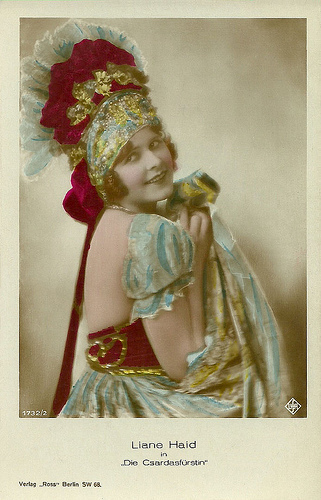
Liane Haid . German postcard by Ross Verlag, no. 1732/2, 1927-1928. Photo: Ufa. Publicity still for Die Csardasfürstin/The Csardas Princess (Hanns Schwarz, 1927). Collection: Didier Hanson.
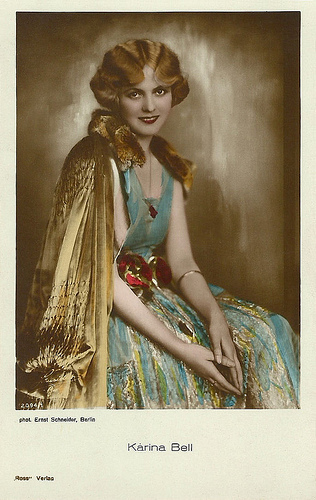
Karina Bell . German postcard by Ross Verlag, no. 2094/1, 1927-1928. Photo: Ernst Schneider, Berlin. Collection: Didier Hanson.
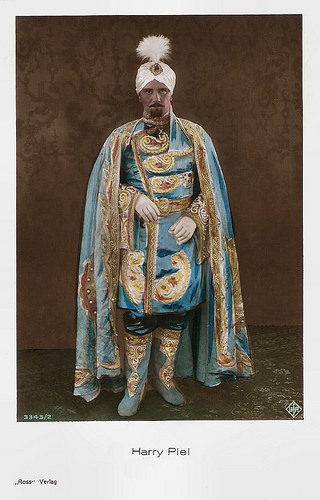
Harry Piel . German postcard by Ross Verlag, Berlin, no. 3343/2, 1928-1929. Photo: Ufa. Publicity still for Panik/Panic (Harry Piel, 1928).
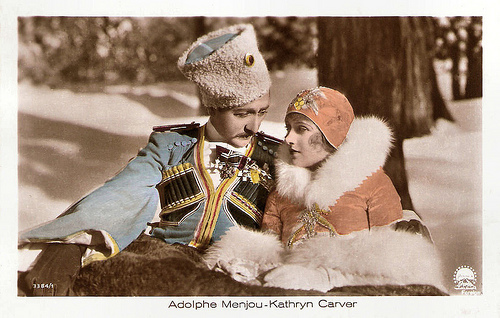
Adolphe Menjou and Kathryn Carver. British postcard by Ross Verlag, no. 3384/1. Photo: Paramount. Publicity still for Service for Ladies (Harry d'Abbadie d'Arrast, 1927).
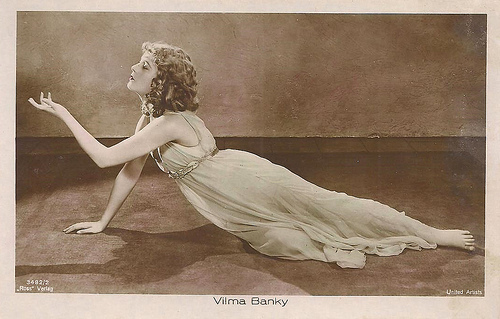
Vilma Banky . German postcard by Ross Verlag, no. 3482/2, 1928-1929. Photo: United Artists. Collection: Joanna.
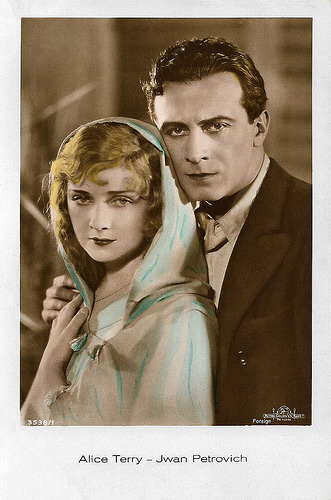
Alice Terry and Iván Petrovich . British postcard by Ross Verlag, no. 3538/1. Photo: Metro-Goldwyn-Mayer. Publicity still for The Garden of Allah (Rex Ingram, 1927).
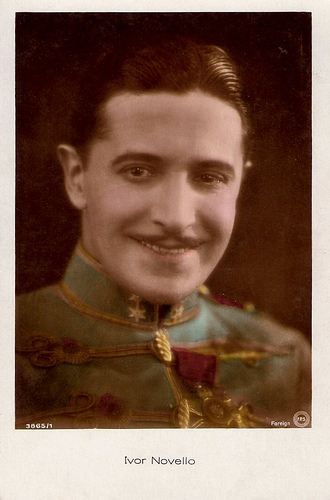
Ivor Novello . British postcard, no. 3865/1. Photo: FPS. At the backside: Real Hand-coloured Photograph.
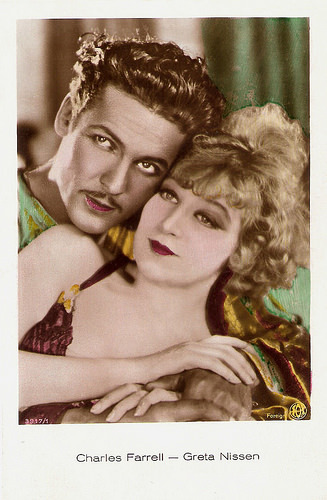
Greta Nissen and Charles Farrell. British postcard by Ross Verlag, no. 3917/1, 1928-1929. Photo: Fox. Publicity still for Fazil (Howard Hawks, 1928).
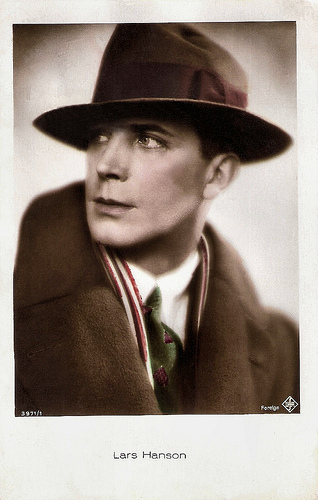
Lars Hanson . British postcard by Ross Verlag, no. 3971/1, 1928-1929. Photo: Ufa.
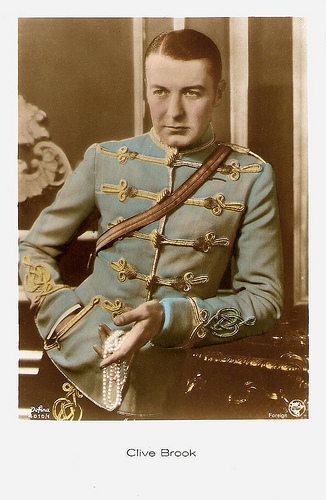
Clive Brook . British postcard by Ross Verlag, no. 4010/1. Photo: Defina / First National Pictures.
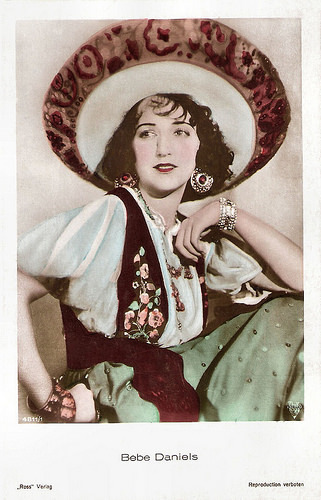
Bebe Daniels . German postcard by Ross Verlag, no. 4811/1, 1929-1930. Photo: RKO Radio Pictures. Collection: Geoffrey Donaldson Institute.
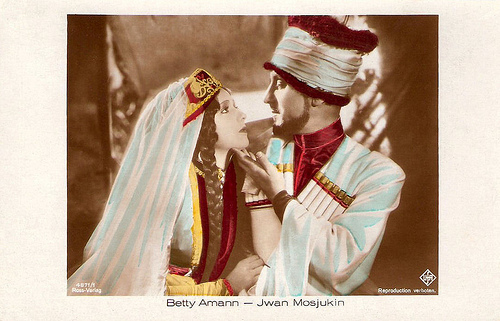
Betty Amann and Ivan Mozzhukhin . German postcard by Ross Verlag, no. 4871/1, 1930. Photo: Michael Powell / Ufa. Publicity still for Der Weisse Teufel/The White Devil (Alexandre Volkoff, 1930).
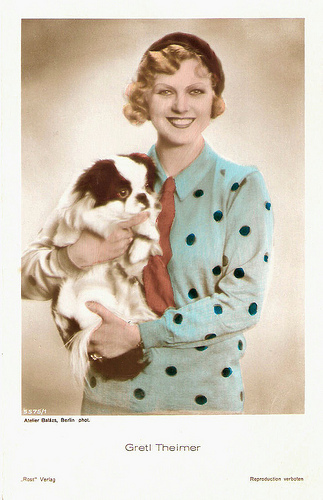
Gretl Theimer . German postcard by Ross Verlag, no. 5575/1, 1930-1931. Photo: Atelier Balázs.
Source: Mark Goffee (Ross Verlag Movie Star Postcards).
It is Postcard Friendship Friday, hosted by Beth at the The Best Hearts are Crunchy. You can visit her by clicking on the button below.


Liane Haid . German postcard by Ross Verlag, no. 1732/2, 1927-1928. Photo: Ufa. Publicity still for Die Csardasfürstin/The Csardas Princess (Hanns Schwarz, 1927). Collection: Didier Hanson.

Karina Bell . German postcard by Ross Verlag, no. 2094/1, 1927-1928. Photo: Ernst Schneider, Berlin. Collection: Didier Hanson.

Harry Piel . German postcard by Ross Verlag, Berlin, no. 3343/2, 1928-1929. Photo: Ufa. Publicity still for Panik/Panic (Harry Piel, 1928).

Adolphe Menjou and Kathryn Carver. British postcard by Ross Verlag, no. 3384/1. Photo: Paramount. Publicity still for Service for Ladies (Harry d'Abbadie d'Arrast, 1927).

Vilma Banky . German postcard by Ross Verlag, no. 3482/2, 1928-1929. Photo: United Artists. Collection: Joanna.

Alice Terry and Iván Petrovich . British postcard by Ross Verlag, no. 3538/1. Photo: Metro-Goldwyn-Mayer. Publicity still for The Garden of Allah (Rex Ingram, 1927).

Ivor Novello . British postcard, no. 3865/1. Photo: FPS. At the backside: Real Hand-coloured Photograph.

Greta Nissen and Charles Farrell. British postcard by Ross Verlag, no. 3917/1, 1928-1929. Photo: Fox. Publicity still for Fazil (Howard Hawks, 1928).

Lars Hanson . British postcard by Ross Verlag, no. 3971/1, 1928-1929. Photo: Ufa.

Clive Brook . British postcard by Ross Verlag, no. 4010/1. Photo: Defina / First National Pictures.

Bebe Daniels . German postcard by Ross Verlag, no. 4811/1, 1929-1930. Photo: RKO Radio Pictures. Collection: Geoffrey Donaldson Institute.

Betty Amann and Ivan Mozzhukhin . German postcard by Ross Verlag, no. 4871/1, 1930. Photo: Michael Powell / Ufa. Publicity still for Der Weisse Teufel/The White Devil (Alexandre Volkoff, 1930).

Gretl Theimer . German postcard by Ross Verlag, no. 5575/1, 1930-1931. Photo: Atelier Balázs.
Source: Mark Goffee (Ross Verlag Movie Star Postcards).
It is Postcard Friendship Friday, hosted by Beth at the The Best Hearts are Crunchy. You can visit her by clicking on the button below.

Published on January 18, 2018 22:00
January 17, 2018
Der Übel größtes aber ist die Schuld (1918)
The title of the silent German drama Der Übel größtes aber ist die Schuld (Hubert Moest, 1918) refers to a line by Cicero, retaken by Friedrich Schiller in the closing lines of his play Die Braut von Messina. Worse than a (self-chosen) death, both claim, is guilt.

German postcard in the Film Sterne series by Rotophot, no. 532/4. Photo: Eiko Film. Hedda Vernon and Josef Peterhans in Der Übel größtes aber ist die Schuld (Hubert Moest, 1918).
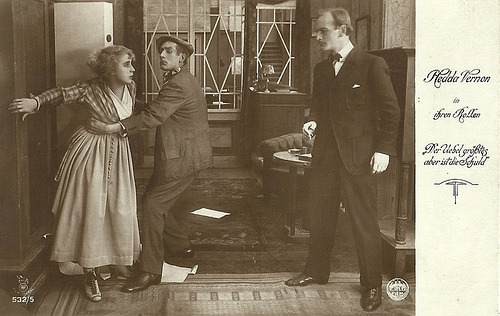
German postcard in the Film Sterne series by Rotophot, no. 532/5. Photo: Eiko Film. Hedda Vernon and Josef Peterhans in Der Übel größtes aber ist die Schuld (Hubert Moest, 1918).
One of the most prolific writers for the German silent film
German actress, writer and producer Hedda Vernon (1866-?) appeared in more than 60 films of the early silent period. During the 1910s she was such a popular film star that she got her own Hedda-Vernon serial. One of these productions was Der Übel größtes aber ist die Schuld (Hubert Moest, 1918).
Der Übel größtes aber ist die Schuld was scripted by German scriptwriter Ruth Goetz, "one of the most prolific writers for film in Germany in the period 1916–1927, with about sixty-five titles including original scripts and adaptations credited to her name", as Mila Ganeva writes on the website Women Film Pioneers project .
Ganeva: "Ruth Goetz was the only woman featured in this special 1918 issue of the Berlin-based trade magazine Kinematograph edited by E.A. Dupont and devoted to the invisible work of scenarists. A year earlier, one of her scripts had been included as a model for aspiring writers in one of the first manuals compiled by Wilhelm Adler. The film based on this script, Noemi, die blonde Jüdin/Noemi, the Blond Jewess (1917), was directed by Hubert Moest and served primarily as a star vehicle for actress Hedda Vernon ."
Director Hubert Moest was Hedda Vernon's husband from 1913 to 1920. After having acted together from 1913 on, he directed her in many films at the Eiko studio in the years 1914-1919.
In 1917-1918 many postcards for Vernon's films were released: Die Verworfenen, Die Narbe am Knie, Noemi, die blonde Jüdin (all 1917), and Puppchen, Fesseln, Der Übel größtes aber ist die Schuld, Mouchy, Das Todesgeheimnis and Wo ein Wille, ist ein Weg (all 1918). All these films were directed by Moest.
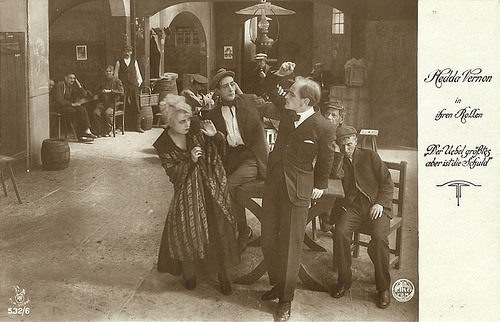
German postcard in the Film Sterne series by Rotophot, no. 532/6. Photo: Eiko Film. Hedda Vernon and Josef Peterhans in Der Übel größtes aber ist die Schuld (Hubert Moest, 1918).
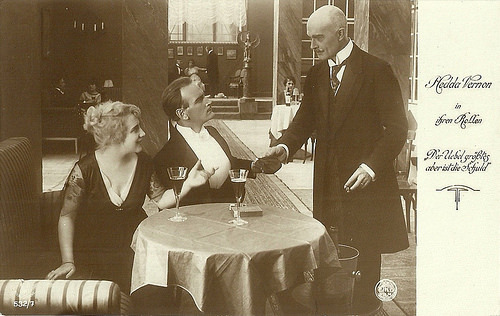
German postcard in the Film Sterne series by Rotophot, no. 532/7. Photo: Eiko Film. Hedda Vernon and Josef Peterhans in Der Übel größtes aber ist die Schuld (Hubert Moest, 1918).
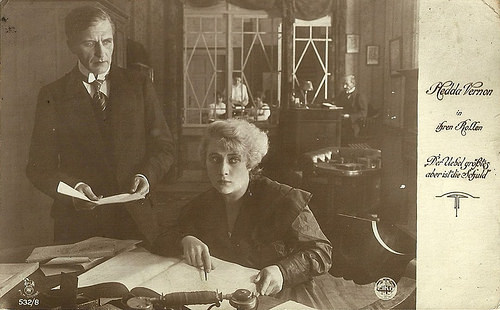
German postcard in the Film Sterne series by Rotophot, no. 532/8. Photo: Eiko Film. Hedda Vernon in Der Übel größtes aber ist die Schuld (Hubert Moest, 1918).
Source: Women Film Pioneers Project; Stephanie D'heil (Steffi-line.de - German), Wikipedia and IMDb.

German postcard in the Film Sterne series by Rotophot, no. 532/4. Photo: Eiko Film. Hedda Vernon and Josef Peterhans in Der Übel größtes aber ist die Schuld (Hubert Moest, 1918).

German postcard in the Film Sterne series by Rotophot, no. 532/5. Photo: Eiko Film. Hedda Vernon and Josef Peterhans in Der Übel größtes aber ist die Schuld (Hubert Moest, 1918).
One of the most prolific writers for the German silent film
German actress, writer and producer Hedda Vernon (1866-?) appeared in more than 60 films of the early silent period. During the 1910s she was such a popular film star that she got her own Hedda-Vernon serial. One of these productions was Der Übel größtes aber ist die Schuld (Hubert Moest, 1918).
Der Übel größtes aber ist die Schuld was scripted by German scriptwriter Ruth Goetz, "one of the most prolific writers for film in Germany in the period 1916–1927, with about sixty-five titles including original scripts and adaptations credited to her name", as Mila Ganeva writes on the website Women Film Pioneers project .
Ganeva: "Ruth Goetz was the only woman featured in this special 1918 issue of the Berlin-based trade magazine Kinematograph edited by E.A. Dupont and devoted to the invisible work of scenarists. A year earlier, one of her scripts had been included as a model for aspiring writers in one of the first manuals compiled by Wilhelm Adler. The film based on this script, Noemi, die blonde Jüdin/Noemi, the Blond Jewess (1917), was directed by Hubert Moest and served primarily as a star vehicle for actress Hedda Vernon ."
Director Hubert Moest was Hedda Vernon's husband from 1913 to 1920. After having acted together from 1913 on, he directed her in many films at the Eiko studio in the years 1914-1919.
In 1917-1918 many postcards for Vernon's films were released: Die Verworfenen, Die Narbe am Knie, Noemi, die blonde Jüdin (all 1917), and Puppchen, Fesseln, Der Übel größtes aber ist die Schuld, Mouchy, Das Todesgeheimnis and Wo ein Wille, ist ein Weg (all 1918). All these films were directed by Moest.

German postcard in the Film Sterne series by Rotophot, no. 532/6. Photo: Eiko Film. Hedda Vernon and Josef Peterhans in Der Übel größtes aber ist die Schuld (Hubert Moest, 1918).

German postcard in the Film Sterne series by Rotophot, no. 532/7. Photo: Eiko Film. Hedda Vernon and Josef Peterhans in Der Übel größtes aber ist die Schuld (Hubert Moest, 1918).

German postcard in the Film Sterne series by Rotophot, no. 532/8. Photo: Eiko Film. Hedda Vernon in Der Übel größtes aber ist die Schuld (Hubert Moest, 1918).
Source: Women Film Pioneers Project; Stephanie D'heil (Steffi-line.de - German), Wikipedia and IMDb.
Published on January 17, 2018 22:00
January 16, 2018
Lilli Palmer
German actress and author Lilli Palmer (1914–1986) appeared in French, British, American and German films. The charming and elegant film star won such prestigious awards as the Coppa Volpi in Italy, the Deutscher Filmpreis, and she was nominated twice for a Golden Globe Award.
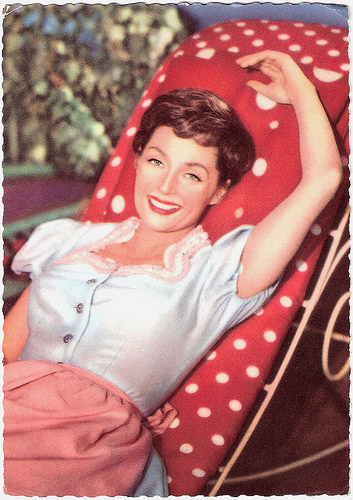
German postcard by Ufa, Berlin-Tempelhof, no. CK-41. Photo: Arthur Grimm.
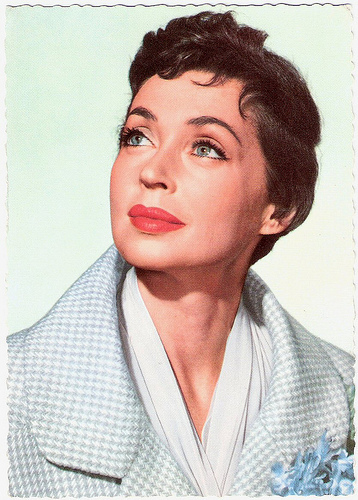
German postcard by Universum-Film Aktiengesellschaft (Ufa), Berlin-Tempelhof, no. CK-136. Retail price: 30 Pfg. Photo: Ringpress / Vogelmann.

German collectors card by Lux.
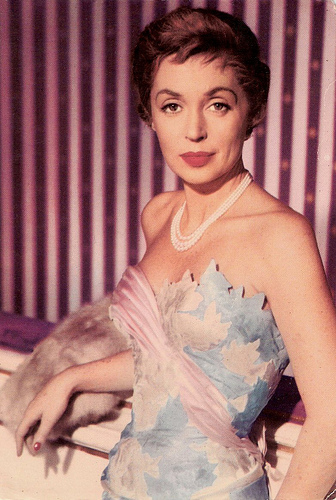
German postcard by ISV, no. M 1. Photo: Europa-Film / List.
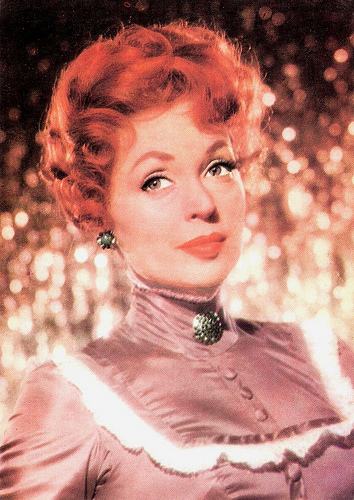
Romanian postcard by Casa Filmului Acin.
Singing and Dancing Duo
Lilli Palmer was born Lilli Marie Peiser in Posen, Germany (now Poznań, Poland) in 1914.
She was one of three daughters born to Dr. Alfred Peiser, a German Jewish surgeon, and Rose Lissman, an Austrian Jewish stage actress. Of her two sisters, older sister Irene Prador became an actress and singer in her own right.
When Lilli was four her family moved to Berlin-Charlottenburg. In addition to her native German, she grew up becoming fluent in French and English as well.
She studied drama from Ilka Grüning and Lucie Höflich in Berlin. There she made her stage debut at the Rose-Theater in 1932 and later appeared at the Hessischen Landestheater in Darmstadt, where she mainly played in comedies and as a soubrette in operettas.
Her first film was the French-German Ufa-production Les riveaux de la piste/Spoiling the Game (Serge de Poligny, 1932) starring Albert Préjean , in which she played a bit part.
After the Nazi takeover in 1933 her family fled to Paris. There Lilli and her sister Irene performed in cabarets as the singing and dancing duo Les Sœurs Viennoises.
Lilli attracted the attention of British talent scouts and was offered a contract by the Gaumont Film Company. She took her surname Palmer from an English actress she admired.
At Gaumont, she started co-starring in the B-mystery drama Crime Unlimited (Ralph Ince, 1935) opposite Esmond Knight and continued to appear in British films for the next decade.
She played a supporting part as a maid in Alfred Hitchcock’s espionage comedy Secret Agent (1936) and she rose to stardom in Britain with the action film The Great Barrier (Geoffrey Barkas, Milton Rosmer, 1937) about the building of the Canadian Pacific Railway.
Another success was the war film Thunder Rock (Roy Boulting, 1942), which starred Michael Redgrave as an anti-fascist journalist who retreats to Canada. Despite these film roles it was her stage career on which she concentrated during her British period.
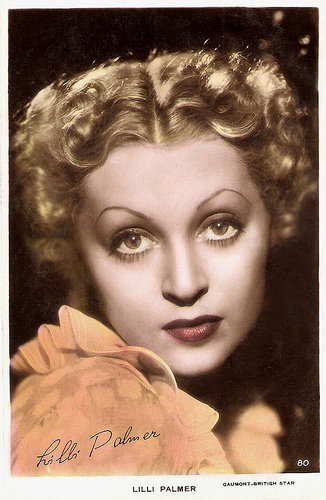
British postcard by Art Card, no. 80. Photo: Gaumont-British. This card dates from the years Palmer played in Alfred Hitchcock's Secret Agent (1936), a Gaumont-British production, and The Great Barrier (Geoffrey Barkas, Milton Rosmer, 1937).
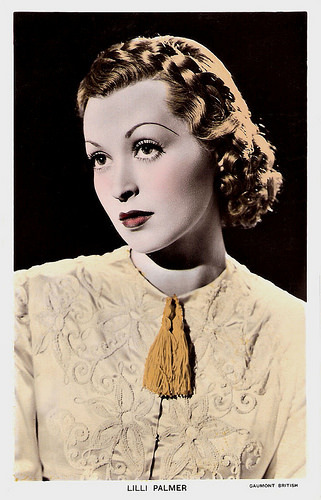
British postcard in the Colourgraph Series, no. C 288. Photo: Gaumont British.
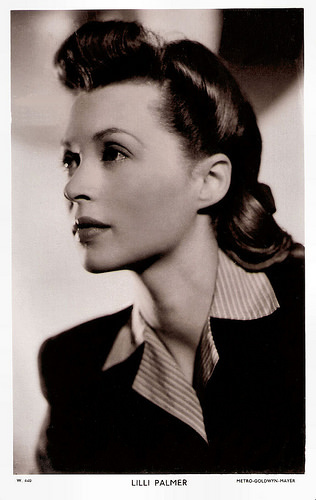
British postcard in the Picturegoer Series, London, no. W. 440. Photo: Metro-Goldwyn-Mayer.
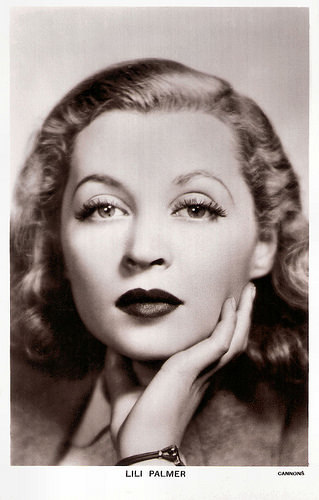
British postcard in the Picturegoer Series, no. 1071 b. Photo: Cannons.
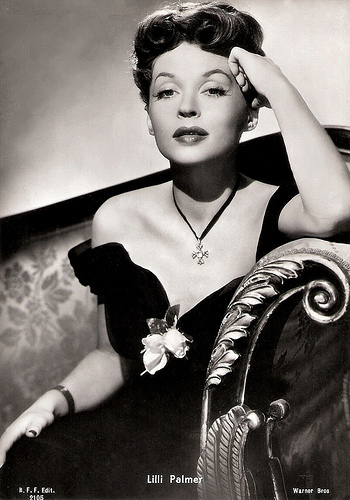
Italian postcard by B.F.F. Edit. (Casa Edite. Ballerini & Fratini, Firenze), no. 2105. Photo: Warner Bros. Warner produced Cloak and Dagger (Fritz Lang, 1946) and other Hollywood productions with Lilli Palmer.
Sexy Rexy
In 1943, Lilli Palmer married actor Rex Harrison and the following year, their son was born, the later writer and director Carey Harrison. Palmer and Harrison starred together in the romantic drama The Rake's Progress (Sidney Gilliat, 1945).
That same year the family moved to Hollywood. Palmer signed with Warner Brothers and appeared in several films, starting with Cloak and Dagger (Fritz Lang, 1946) opposite Gary Cooper. She also appeared in the classic boxing film Body and Soul (Robert Rossen, 1947) starring John Garfield.
During their marriage, Rex Harrison had many affairs, including one with starlet Carole Landis, who committed suicide in 1948 in the wake of their failed relationship. The scandal nearly caused the end of the film careers of both Palmer and her ’Sexy Rexy’, as Harrison was known in the tabloids.
Palmer took the high road and came off the better for it in the public’s eye. She appeared in stage plays as well hosted her own television series, the (short-lived) The Lilli Palmer Show (1953).
Together with Harrison she performed on Broadway where they had a hit with the play Bell, Book and Candle. Later they also starred together in the film version of The Four Poster (Irving Reis, 1952), which was based on the award-winning Broadway play of the same name, written by Jan de Hartog.
Palmer won the Coppa Volpi (Volpi Cup) for Best Actress in 1953 for The Four Poster. She eventually called it quits, however, with both Harrison and Hollywood. She divorced from Harrison in 1956.
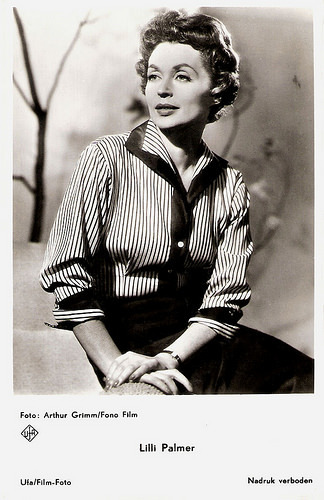
Dutch postcard by Gebr. Spanjersberg N.V., Rotterdam, no. 1979. Photo: Arthur Grimm / Fono Film / Ufa.
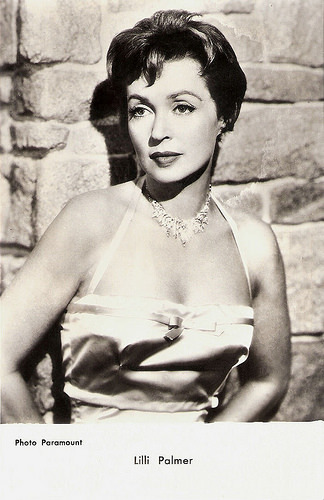
French postcard by Editions P.I., Paris, offered by Les Carbones Korès 'Carboplane', no. A 1065 A. Photo: Paramount.
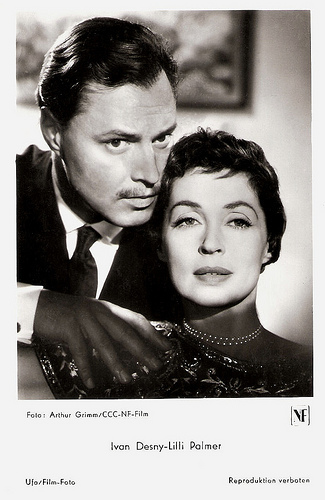
German postcard by Ufa, Wanne-Eickel, no. 393. Photo: Arthur Grimm / CCC / NF-Film. Publicity still for Anastasia - Die letzte Zarentochter/Anastasia: The Czar's Last Daughter (Falk Harnack, 1956) with Ivan Desny .
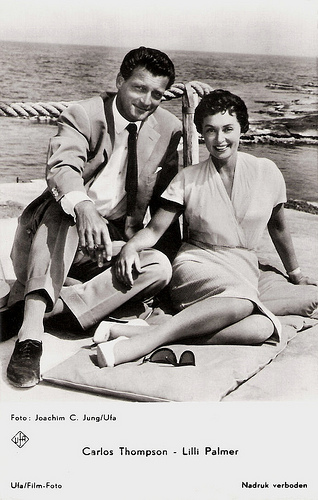
With Carlos Thompson . Dutch postcard by Gebr. Spanjersberg N.V., Rotterdam, no. 4061. Photo: Joachim C. Jung / Ufa.
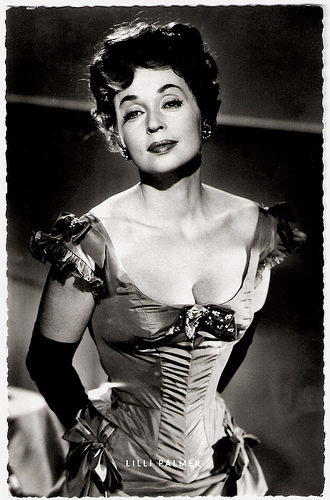
German postcard by Kunst und Bild, Berlin-Charlottenburg, no. A 1587. Photo: Gabriele / Bavaria / Schorcht. Publicity still for Eine Frau die weiss was Sie will/Mother of Pearl (Arthur Maria Rabenalt, 1958).
Argentine Matinee Idol
Lilli Palmer returned to Germany in 1954. Her first role in a German film was the part of a ringmaster in Kurt Hoffmann's Feuerwerk/Fireworks (1954) with Romy Schneider .
She often played in so-called ‘problem films’ and won the Deutscher Filmpreis for Best Actress for her performances in Teufel in Seide/Devil in Silk, (Rolf Hansen, 1955) and in Anastasia, die letzte Zarentochter/Anastasia: The Czar's Last Daughter (Falk Harnack, 1956).
When Palmer filmed Zwischen Zeit und Ewigkeit/Between Time and Eternity (Arthur Maria Rabenalt, 1956), she fell in love with her co-star, Argentine matinee idol Carlos Thompson . They married a year later.
During the following decades she continued to play both leading and supporting parts in Europe and the US. She starred opposite William Holden in The Counterfeit Traitor (George Seaton, 1962), a spy thriller based on fact, and opposite Robert Taylor in another true World War II story, Disney's Miracle of the White Stallions (Arthur Hiller, 1963).
She also played roles in many television productions, including in episodes of such popular Krimi series as Der Kommissar/The Inspector (1971) and Derrick (1974). In 1974 she also starred with John Mills in the British series The Zoo Gang (Sidney Hayers, John Hough, 1974), about a group of former underground freedom fighters from World War II.
Gary Brumburgh at IMDb : "The final decade and a half played out rather routinely with supporting roles in such films as diverse as Oedipus the King (1968), De Sade (1969), and The Boys from Brazil (1978)." She enjoyed one of her last roles in the acclaimed miniseries Peter the Great (Marvin J. Chomsky, Lawrence Schiller, 1986) starring Maximilian Schell . It earned her another Golden Globe Award nomination.
A talented writer, Palmer published a successful memoir, Dicke Lilli – gutes Kind (1974)/Change Lobsters and Dance (1975). She also wrote a full-length work of fiction presented as a novel rather than a memoir, Der rote Rabe (1977)/The Red Raven (1978). Four novels followed, while she also had success as a painter.
In 1974 she was awarded the Großes Verdienstkreuz der Bundesrepublik Deutschland (the Great Cross of Merit of the Federal Republic of Germany), and in 1978, she won the Filmband in Gold for her long-time, exceptional work in German cinema.
Lilli Palmer was still married to Carlos Thompson when she died in Los Angeles from cancer in 1986. She was 71. Thompson committed suicide four years later back in his native Argentina.
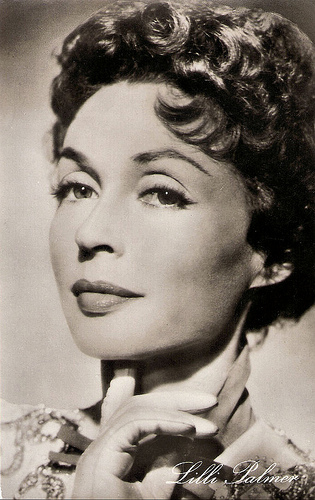
East-German postcard by VEB Progress Film-Vertrieb, Berlin, no. 223, 1957. Photo: NDF / Schorcht. Publicity still for Feuerwerk/Fireworks (Kurt Hoffmann, 1954).
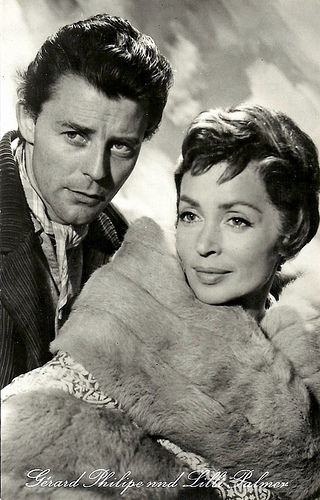
East-German postcard by VEB Progress-Filmvertrieb, Berlin, no. 1271. Photo: Progress. Publicity still of Gérard Philipe and Lilli Palmer in Montparnasse 19/The Lovers of Montparnasse (Jacques Becker, Max Ophüls 1958), a biopic on the last year of painter Amedeo Modigliani.
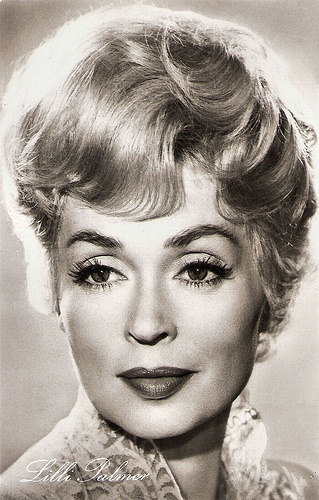
East-German postcard by VEB Progress Film-Vertrieb, Berlin, no. 1304, 1960. Photo: publicity still for Frau Warrens Gewerbe/Mrs. Warren's Profession (Ákos Ráthonyi, 1960).
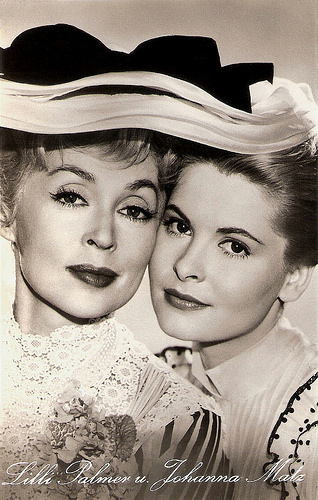
East-German postcard by Progress, no. 1306, 1960. Photo: publicity still for Frau Warrens Gewerbe/Mrs. Warren's Profession (Ákos Ráthonyi, 1960) with Johanna Matz .
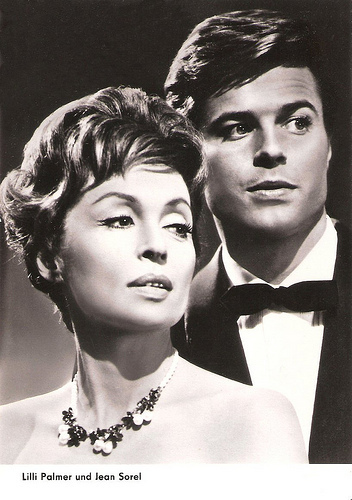
East-German postcard by VEB Progress, Berlin, no. 1897, 1964. Retail price: 0,20 DM. Photo: Progress. Publicity still for Julia, du bist Zauberhaft/Adorable Julia (Alfred Weidenmann, 1962) with Jean Sorel .

East-German postcard by VEB Progress Film-Vertrieb, Berlin, no. 2993, 1967. Photo: Steffen.
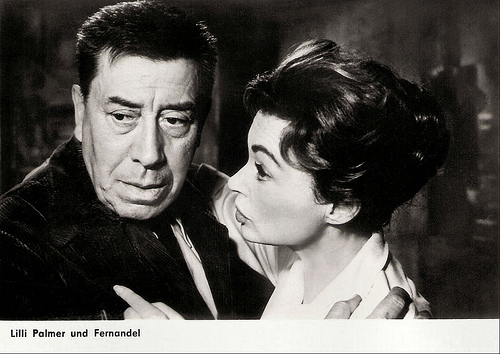
German postcard by Progress, no. 2994, 1967. Retail price: 0,20 DM. Photo: publicity still for Le voyage du père/Father's Trip (Denys de La Patellière, 1966) with Fernandel .
Trailer of Mädchen in Uniform (1958) with Romy Schneider . Source: 3DollarBillCinema (YouTube).
Sources: (IMDb), Filmportal.de, Wikipedia (English and German), and .

German postcard by Ufa, Berlin-Tempelhof, no. CK-41. Photo: Arthur Grimm.

German postcard by Universum-Film Aktiengesellschaft (Ufa), Berlin-Tempelhof, no. CK-136. Retail price: 30 Pfg. Photo: Ringpress / Vogelmann.

German collectors card by Lux.

German postcard by ISV, no. M 1. Photo: Europa-Film / List.

Romanian postcard by Casa Filmului Acin.
Singing and Dancing Duo
Lilli Palmer was born Lilli Marie Peiser in Posen, Germany (now Poznań, Poland) in 1914.
She was one of three daughters born to Dr. Alfred Peiser, a German Jewish surgeon, and Rose Lissman, an Austrian Jewish stage actress. Of her two sisters, older sister Irene Prador became an actress and singer in her own right.
When Lilli was four her family moved to Berlin-Charlottenburg. In addition to her native German, she grew up becoming fluent in French and English as well.
She studied drama from Ilka Grüning and Lucie Höflich in Berlin. There she made her stage debut at the Rose-Theater in 1932 and later appeared at the Hessischen Landestheater in Darmstadt, where she mainly played in comedies and as a soubrette in operettas.
Her first film was the French-German Ufa-production Les riveaux de la piste/Spoiling the Game (Serge de Poligny, 1932) starring Albert Préjean , in which she played a bit part.
After the Nazi takeover in 1933 her family fled to Paris. There Lilli and her sister Irene performed in cabarets as the singing and dancing duo Les Sœurs Viennoises.
Lilli attracted the attention of British talent scouts and was offered a contract by the Gaumont Film Company. She took her surname Palmer from an English actress she admired.
At Gaumont, she started co-starring in the B-mystery drama Crime Unlimited (Ralph Ince, 1935) opposite Esmond Knight and continued to appear in British films for the next decade.
She played a supporting part as a maid in Alfred Hitchcock’s espionage comedy Secret Agent (1936) and she rose to stardom in Britain with the action film The Great Barrier (Geoffrey Barkas, Milton Rosmer, 1937) about the building of the Canadian Pacific Railway.
Another success was the war film Thunder Rock (Roy Boulting, 1942), which starred Michael Redgrave as an anti-fascist journalist who retreats to Canada. Despite these film roles it was her stage career on which she concentrated during her British period.

British postcard by Art Card, no. 80. Photo: Gaumont-British. This card dates from the years Palmer played in Alfred Hitchcock's Secret Agent (1936), a Gaumont-British production, and The Great Barrier (Geoffrey Barkas, Milton Rosmer, 1937).

British postcard in the Colourgraph Series, no. C 288. Photo: Gaumont British.

British postcard in the Picturegoer Series, London, no. W. 440. Photo: Metro-Goldwyn-Mayer.

British postcard in the Picturegoer Series, no. 1071 b. Photo: Cannons.

Italian postcard by B.F.F. Edit. (Casa Edite. Ballerini & Fratini, Firenze), no. 2105. Photo: Warner Bros. Warner produced Cloak and Dagger (Fritz Lang, 1946) and other Hollywood productions with Lilli Palmer.
Sexy Rexy
In 1943, Lilli Palmer married actor Rex Harrison and the following year, their son was born, the later writer and director Carey Harrison. Palmer and Harrison starred together in the romantic drama The Rake's Progress (Sidney Gilliat, 1945).
That same year the family moved to Hollywood. Palmer signed with Warner Brothers and appeared in several films, starting with Cloak and Dagger (Fritz Lang, 1946) opposite Gary Cooper. She also appeared in the classic boxing film Body and Soul (Robert Rossen, 1947) starring John Garfield.
During their marriage, Rex Harrison had many affairs, including one with starlet Carole Landis, who committed suicide in 1948 in the wake of their failed relationship. The scandal nearly caused the end of the film careers of both Palmer and her ’Sexy Rexy’, as Harrison was known in the tabloids.
Palmer took the high road and came off the better for it in the public’s eye. She appeared in stage plays as well hosted her own television series, the (short-lived) The Lilli Palmer Show (1953).
Together with Harrison she performed on Broadway where they had a hit with the play Bell, Book and Candle. Later they also starred together in the film version of The Four Poster (Irving Reis, 1952), which was based on the award-winning Broadway play of the same name, written by Jan de Hartog.
Palmer won the Coppa Volpi (Volpi Cup) for Best Actress in 1953 for The Four Poster. She eventually called it quits, however, with both Harrison and Hollywood. She divorced from Harrison in 1956.

Dutch postcard by Gebr. Spanjersberg N.V., Rotterdam, no. 1979. Photo: Arthur Grimm / Fono Film / Ufa.

French postcard by Editions P.I., Paris, offered by Les Carbones Korès 'Carboplane', no. A 1065 A. Photo: Paramount.

German postcard by Ufa, Wanne-Eickel, no. 393. Photo: Arthur Grimm / CCC / NF-Film. Publicity still for Anastasia - Die letzte Zarentochter/Anastasia: The Czar's Last Daughter (Falk Harnack, 1956) with Ivan Desny .

With Carlos Thompson . Dutch postcard by Gebr. Spanjersberg N.V., Rotterdam, no. 4061. Photo: Joachim C. Jung / Ufa.

German postcard by Kunst und Bild, Berlin-Charlottenburg, no. A 1587. Photo: Gabriele / Bavaria / Schorcht. Publicity still for Eine Frau die weiss was Sie will/Mother of Pearl (Arthur Maria Rabenalt, 1958).
Argentine Matinee Idol
Lilli Palmer returned to Germany in 1954. Her first role in a German film was the part of a ringmaster in Kurt Hoffmann's Feuerwerk/Fireworks (1954) with Romy Schneider .
She often played in so-called ‘problem films’ and won the Deutscher Filmpreis for Best Actress for her performances in Teufel in Seide/Devil in Silk, (Rolf Hansen, 1955) and in Anastasia, die letzte Zarentochter/Anastasia: The Czar's Last Daughter (Falk Harnack, 1956).
When Palmer filmed Zwischen Zeit und Ewigkeit/Between Time and Eternity (Arthur Maria Rabenalt, 1956), she fell in love with her co-star, Argentine matinee idol Carlos Thompson . They married a year later.
During the following decades she continued to play both leading and supporting parts in Europe and the US. She starred opposite William Holden in The Counterfeit Traitor (George Seaton, 1962), a spy thriller based on fact, and opposite Robert Taylor in another true World War II story, Disney's Miracle of the White Stallions (Arthur Hiller, 1963).
She also played roles in many television productions, including in episodes of such popular Krimi series as Der Kommissar/The Inspector (1971) and Derrick (1974). In 1974 she also starred with John Mills in the British series The Zoo Gang (Sidney Hayers, John Hough, 1974), about a group of former underground freedom fighters from World War II.
Gary Brumburgh at IMDb : "The final decade and a half played out rather routinely with supporting roles in such films as diverse as Oedipus the King (1968), De Sade (1969), and The Boys from Brazil (1978)." She enjoyed one of her last roles in the acclaimed miniseries Peter the Great (Marvin J. Chomsky, Lawrence Schiller, 1986) starring Maximilian Schell . It earned her another Golden Globe Award nomination.
A talented writer, Palmer published a successful memoir, Dicke Lilli – gutes Kind (1974)/Change Lobsters and Dance (1975). She also wrote a full-length work of fiction presented as a novel rather than a memoir, Der rote Rabe (1977)/The Red Raven (1978). Four novels followed, while she also had success as a painter.
In 1974 she was awarded the Großes Verdienstkreuz der Bundesrepublik Deutschland (the Great Cross of Merit of the Federal Republic of Germany), and in 1978, she won the Filmband in Gold for her long-time, exceptional work in German cinema.
Lilli Palmer was still married to Carlos Thompson when she died in Los Angeles from cancer in 1986. She was 71. Thompson committed suicide four years later back in his native Argentina.

East-German postcard by VEB Progress Film-Vertrieb, Berlin, no. 223, 1957. Photo: NDF / Schorcht. Publicity still for Feuerwerk/Fireworks (Kurt Hoffmann, 1954).

East-German postcard by VEB Progress-Filmvertrieb, Berlin, no. 1271. Photo: Progress. Publicity still of Gérard Philipe and Lilli Palmer in Montparnasse 19/The Lovers of Montparnasse (Jacques Becker, Max Ophüls 1958), a biopic on the last year of painter Amedeo Modigliani.

East-German postcard by VEB Progress Film-Vertrieb, Berlin, no. 1304, 1960. Photo: publicity still for Frau Warrens Gewerbe/Mrs. Warren's Profession (Ákos Ráthonyi, 1960).

East-German postcard by Progress, no. 1306, 1960. Photo: publicity still for Frau Warrens Gewerbe/Mrs. Warren's Profession (Ákos Ráthonyi, 1960) with Johanna Matz .

East-German postcard by VEB Progress, Berlin, no. 1897, 1964. Retail price: 0,20 DM. Photo: Progress. Publicity still for Julia, du bist Zauberhaft/Adorable Julia (Alfred Weidenmann, 1962) with Jean Sorel .

East-German postcard by VEB Progress Film-Vertrieb, Berlin, no. 2993, 1967. Photo: Steffen.

German postcard by Progress, no. 2994, 1967. Retail price: 0,20 DM. Photo: publicity still for Le voyage du père/Father's Trip (Denys de La Patellière, 1966) with Fernandel .
Trailer of Mädchen in Uniform (1958) with Romy Schneider . Source: 3DollarBillCinema (YouTube).
Sources: (IMDb), Filmportal.de, Wikipedia (English and German), and .
Published on January 16, 2018 22:00
Paul van Yperen's Blog
- Paul van Yperen's profile
- 13 followers
Paul van Yperen isn't a Goodreads Author
(yet),
but they
do have a blog,
so here are some recent posts imported from
their feed.



